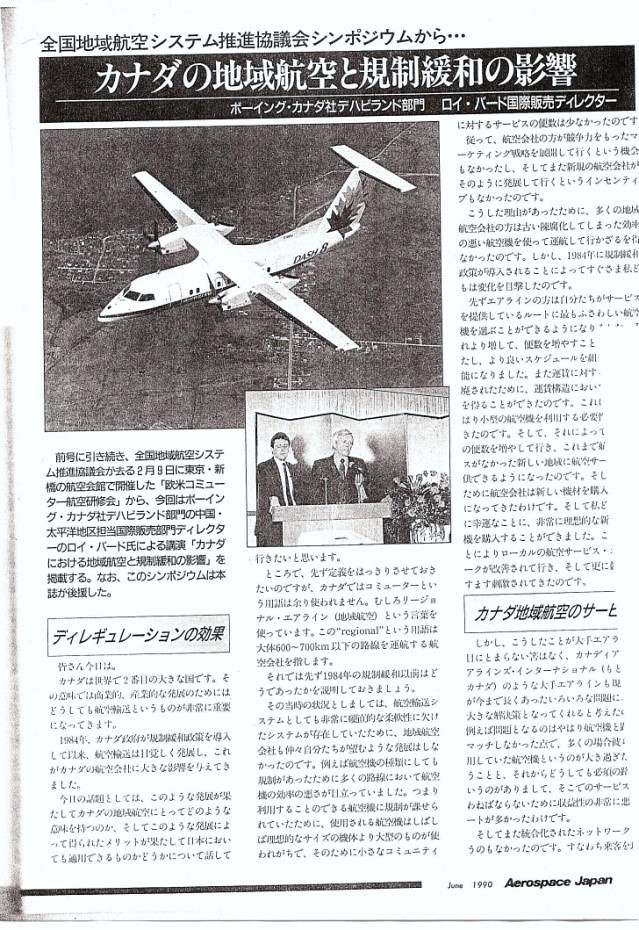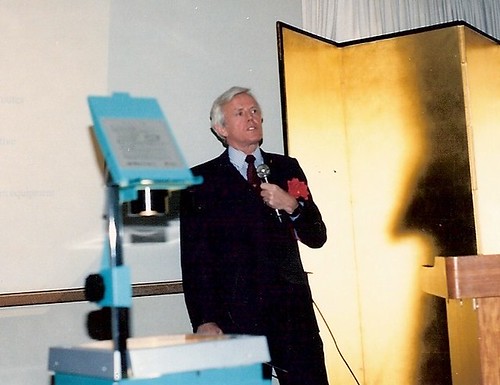Part One: The Plane Truth!
Looking through the list of my previous blogs I am astonished that after nearly fifty verbal outpourings, there is no mention of my aviation background. Since this constituted almost all my working life, to have totally ignored it must be another manifestation of creeping decrepitude. For over 40 years I spent most of my time around aircraft, and they in their turn spent a similar amount around me! Accordingly what follows gives an overview of what was, for the most part, an exciting and absorbing lifestyle for which I was actually paid! I was extremely fortunate as much of my experience, particularly in the arena of flight test, is nowadays very much a thing of the past. Indeed the time frame involved in the following, essentially the second half of the twentieth century, was a period during which the most dramatic developments occurred and civil aviation matured into its current form. Rather than making this merely a personal memoir, I have attempted to deal at least equally with the aircraft themselves and their foibles.
My interest in aircraft, which amounted almost to an obsession, began during WW2 when I was a mere slip of a lad. My first aeronautical exposure to the world, albeit firmly attached to terra-firma came as the pilot of a rudimentary child's tricycle which had been comprehensive modified by two kindly ladies for a local fancy dress competition (with a war theme). I finished a commendable second to a mobile anti-aircraft searchlight, the rear of which can be seen below.
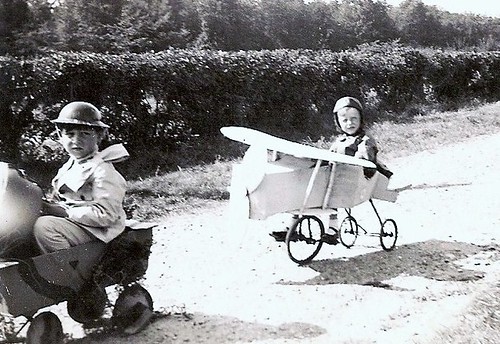
My first solo! Some ladies produced this "airframe" for a fancy dress competition!
Every sound having any similarity to an aircraft engine was sufficient to produce a reflex action in my neck, tilting the head back thus optimizing the position of my eyes eyes to search for its source. In most cases it was emanating from the exhaust stacks of Gipsy Major engines which provided the motive force to propel an armada of yellow de Havilland Tiger Moths based at nearby Booker Airfield. From here they took aspiring pilots aloft where, twirling and ppirouetting through the sky they provided flying instruction, sometimes including an intimate repeat introduction to their breakfast menu!
Every sound having any similarity to an aircraft engine was sufficient to produce a reflex action in my neck, tilting the head back thus optimizing the position of my eyes eyes to search for its source. In most cases it was emanating from the exhaust stacks of Gipsy Major engines which provided the motive force to propel an armada of yellow de Havilland Tiger Moths based at nearby Booker Airfield. From here they took aspiring pilots aloft where, twirling and ppirouetting through the sky they provided flying instruction, sometimes including an intimate repeat introduction to their breakfast menu!
As well as this, from various locations, there were a number of larger communications aircraft such as radial-engined Avro Ansons, Airspeed Oxfords and others having more serious mission statements involving possible encounters with the Luftwaffe or German anti-aircraft guns. A far from complete list included the ubiquitous DC3 (Dakota) and DC4 transports, Fairey Battles, Boulton-Paul Defiants, Westland Lysanders, Halifax and Stirling bombers and often the unmistakable Merlin music emanating from Spitfires, Hurricanes, Lancasters and my perennial favourite, the de Havilland Mosquito.
My introduction to flying was in a de Havilland Tiger Moth.
Later on the same day, I doubled my flying experience in an Auster 5 (below).
Suitably enthused, I immediately added my name to list of those who wished to embark on a primary gliding course to be carried out at Booker over several week-ends. At the time, no two seat gliders were available, accordingly all training was carried out on single-seat Kirby Cadet trainers. Initially to prevent actual lift-off, boards were strapped to the leading edges of the wings, the whole ensemble being towed along the airfield whilst the victim-in-training attempted to steer straight and keep the wings level with rudder and ailerons respectively. The next stage involved the removal of the boards and now to everyone's excitement the Cadet was allowed to become airborne and at a dizzy altitude of 10 feet sedately progressed across the grassy surface. Ultimately, each student was towed to 100 feet or thereabouts, the cable released and the objective was to remain airborne for a minimum of 30 seconds -not difficult provided that control inputs were correctly coordinated. Those successful were awarded their "A" Certificate but there it all stopped. There was no opportunity to progress to the more comprehensive and exciting "B" and "C" levels -the latter involving soaring flight. However as a means of generating an interest in flying for young potential pilots, it was extremely successful.
Kirby Cadet glider. All flights were solo!
To further augment this embryonic enthusiasm in flying, during holiday periods,the CCF organised courses at various RAF stations, each of which dealt with a particular aspect of flying such as flight engineering, radio operating and navigation. RAF Hullavington in Wiltshire specialized in navigation and offered an under-canvas week long course in the subject which I attended. All of these courses involved some flying in either Avro Ansons or Airspeed Oxford aircraft. These again were aimed at further stimulating flying enthusiasts, but at the same time, the somewhat academic classroom activities successfully weeded out those for whom piloting had been seen as a purely glamorous lifestyle requiring little or preferably no concomitant brain exertion .
Avro Anson (left) and Airspeed Oxford, both powered by "Cheetah" radial engines, known by the aviation intelligentsia as the 'Annie' and 'Ox Box' respectively. As an Air Cadet, I flew a number of times on both types.
Wartime 1940's. An RAF Annie takes off behind an Ox Box.
After leaving school I had a window of 15 months opportunity before presenting myself for the mandatory two years of military service. During this time was employed (again at RAF Booker) with the Airwork company which had a contract to maintain aircraft operated by the University of London Air Squadron. They operated a fleet of new de Havilland (Canada) DH1 Chipmunks which was the worthy successor to the ubiquitous Tiger Moth. Powered by an uprated Gipsy Major 10 and of metal construction it was- and still is a handsome and capable little aircraft.
My duties were initially those of a tarmac hand or "ramp rat". whose duties consisted of positioning the aircraft out onto the flight line in the morning, supervising the parking and safely returning them into the hangar at the conclusion of the day's flying activities. Refueling was also our responsibility as was the somewhat intimidating function of hand starting the engine by swinging the propeller. The Chipmunk possessed a 12 gauge cartridge mechanism for starting but despite the risk of losing an arm, the manual method being cheaper, was the preferred alternative! Later on I was promoted to the role of "improver" which inferred a level of competence somewhat beyond that which the standard definition of the word might expect. This involved all manner of maintenance including the complete stripping down and overhaul of Gipsy Major cylinder heads, a task that was left to me with astonishingly little supervision. Incorporation of on-going manufacturers technical modifications also fell within my purview. The only factor which gave my employers some small measure of confidence in my abilities was that on a few occasions I was invited (challenged?) to take a Chipmunk flight in aircraft most of which had at some time received my technical attention. Happily nothing radical occurred. Sometimes I was invited to "take the stick" which was all very morale boosting and developed into a life-long affection for the beautifully proportioned little Chipmunk, many of which are still flying sixty years later.
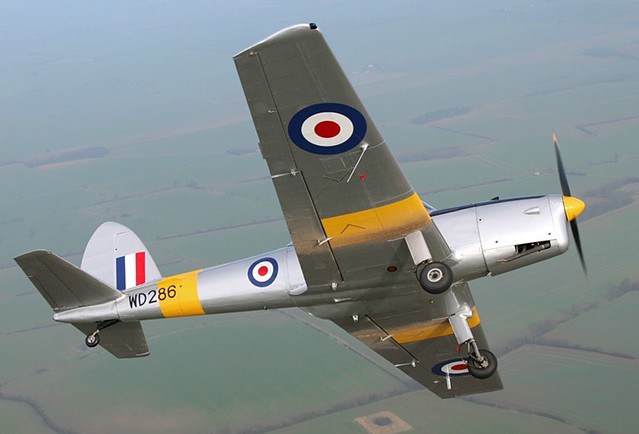
The delightful de Havilland (Canada) DHC1 Chipmunk.
With my military conscription date drawing close, I attended the Aircrew Selection Centre at Hornchurch for an intensive three day programme. This involved many manual dexterity tests -in particular involving hand/eye coordination, putting round pegs in square holes an academic paper including mathematics test plus a detailed medical examination. Finally there were some quite penetrating interviews in front of a panel. Despite my mediocre school academic record, I was offered the role of Air Gunner, a role which was destined to shortly to become redundant. My CCF background and particularly my year with Airwork seemed to have been the clincher. Indeed it was suggested that if I signed on for eight years, my pilot application would be reviewed. For no good reason other than the lengthy commitment, to my eternal regret I turned it down.
Upon handing in my notice to Airwork I was somewhat gratified when they offered to apply for a deferment to my conscription due to my apparent improving "improver"activities. Again I turned the offer down and in June 1952, presented myself at the RAF acceptance center at Padgate in Lancashire, prior to being posted along with 18 other aspiring Air Signallers and Air Gunners to RAF West Kirby for eight weeks of basic training, commonly referred to as "square bashing". Being somewhat used to the fairly harsh discipline and associated indignities associated with CCF courses I found the process quite tolerable -even entertaining, and breezed through it unscathed, more so than some of my mortified colleagues unused to such abuse and disrespect.
Eight weekslater, I was posted to the Central Gunnery School at RAF Leconfield in Yorkshire for aircrew training.
Due to my recent background and despite my protestations, I was "elected" to be course leader, a duty which mainly involved scheduling our upcoming activities with the Officer-in-Charge and ensuring that my flock was always in the right place at the right time. The aircraft in which we would be trained was the Avro Lincoln, a development of the wartime Lancaster. Featuring an extended wing span and up-rated Merlin engines equipped with four bladed propellers, its capabilities were significantly enhanced over those of its predecessor. The next eight weeks were quite intensive and involved daily flights inter-dispersed with classroom lectures as well as live gunnery exercises at a nearby range, featuring the types of weapons fitted to the Lincoln including .5" Browning machine guns and 20mm Hispano cannons. Additionally there were also Lee Enfield .303 rifles, Bren guns, the dreadful Sten gun and somewhat surprisingly the .38 Smith and Wesson revolver which was standard aircrew equipment for aircrew operating over hostile territory. Whether this was to resist capture or to commit suicide was not clear. Detailed instruction on the design of the Boulton Paul rear and Bristol mid-upper gun turrets and their guns preceded operation in flight including firing live rounds. The most memorable things I remember about the Lincoln were take-offs where both gunners were positioned in the fuselage braced against the main spar. The noise was absolutely deafening and and the transfer of vibration to our backs through the main spar was almost mind-numbing. Also it was remarkable how cold it could be sitting in the tail turret for a couple of hours.
The subject of Aircraft Recognition was of critical importance. The identification of attacking aircraft and its wingspan was essential as the graticule* gun sight required calibration using the wing span of the aggressor to achieve any measure of accuracy. This was a subject in which I excelled. Finally of course was the flying itself, which mainly took the form of sorties in coordination with local fighter squadrons whose Meteors or Vampire aircraft would attack us from every angle whilst we would attempt to shoot them down. In the interests of minimizing costs and loss of life, the ammunition was in the form of 16mm cine film integrated with the gun sights. This gave a movie record of each attack including the position of our "foe" with the graticule superimposed on the film indicating our aiming accuracy. Our other main function was to assume the role of narrator during evasion exercises where we were required to instruct the pilot to undertake violent manouevres to foil the attacks by our aggressors. This includes the stomach-churning "corkscrew" maneuver which feels like it sounds.The course was very interesting and enjoyable without the disciplinary burden of West Kirby and in the concluding examination, I was pleased to rank third in our group of eighteen with a comfortable first in Aircraft Recognition.
The subject of Aircraft Recognition was of critical importance. The identification of attacking aircraft and its wingspan was essential as the graticule* gun sight required calibration using the wing span of the aggressor to achieve any measure of accuracy. This was a subject in which I excelled. Finally of course was the flying itself, which mainly took the form of sorties in coordination with local fighter squadrons whose Meteors or Vampire aircraft would attack us from every angle whilst we would attempt to shoot them down. In the interests of minimizing costs and loss of life, the ammunition was in the form of 16mm cine film integrated with the gun sights. This gave a movie record of each attack including the position of our "foe" with the graticule superimposed on the film indicating our aiming accuracy. Our other main function was to assume the role of narrator during evasion exercises where we were required to instruct the pilot to undertake violent manouevres to foil the attacks by our aggressors. This includes the stomach-churning "corkscrew" maneuver which feels like it sounds.The course was very interesting and enjoyable without the disciplinary burden of West Kirby and in the concluding examination, I was pleased to rank third in our group of eighteen with a comfortable first in Aircraft Recognition.
* the graticule sight consisted of a central light "sun"with a ring of "planets" positioned equidistant around it. The aim was to position the central light on the nose. Having input the enemies' wingspan, the diameter of the outer ring was increased or decreased from the gun sight, the aim being to make its diameter coincide with the enemy's wingtips.
Before finally dispersing from Leconfield, having completed our initial aircrew training, we were presented with sergeants' stripes plus the coveted winged Air Gunner brevet! After a few days leave, I was instructed to proceed to RAF Coningsby in Lincolnshire for operational training on the Boeing B29 Super-fortress which, known by the RAF as the "Washington" was surprisingly its front line bomber. The B29 was a very different animal to the Lincoln. Featuring pressurization it was no longer necessary to dress like Nanook of the North to go flying! It possessed no fewer than thirteen guns housed in five turrets, two upper and two lower, plus the tail as can be seen in the images below. It was now no longer required to sit in a turret. Accommodation took the form of comfortable padded seats in front of a small rotatable remote console forming the gun sight. The electronic gunnery system was really state of the art. All guns could be activated by a Central Fire Controller situated in a fully rotatable seat under the small "blister" visible above and behind the RAF roundel (-see images below). The other two blisters directly behind the roundel housed two other gunners. The rear position at the base of the fin entirely isolated from the rest of the aircraft. It was rarely occupied, although I had the misfortune on two occasions to spend eight hours (each flight!) there in claustrophobic solitude. To exit this turret it was necessary for the aircraft to depressurize first; something that would require a descent and an end to the sortie. The Central Fire Controller from his elevated position had the ability to control all thirteen guns and from his 360 deg outlook position, allocate any or all of the 13 guns to the other positions if he judged that they were more likely to achieve success. There were three pressurized sections: the forward flight deck, a central section containing the three air gunners plus a radar navigator and finally the rear turret. A tunnel ran along the roof of the fuselage over the bomb bay connecting the front with the centre location. This required a measure of crawling athleticism to negotiate and was avoided where possible. An additional role of the gunners was to operate the rear located "Ranger" auxiliary power unit (APU) known as the Phut-Phut, used to augment electrical power before take off and prior to landing. However and most importantly, gunners were responsible for the operation of a heater unit to provide hot food during the lengthy five hours or more sorties. Here after heating, cans of soup were transferred to the flight deck via the aforementioned tunnel. Here is where cricketers excelled and a good off speed bowler could impart a measure of spin to the cans sufficient to impart a spiral trajectory along the tunnel and into the arms (-or face!) of the recipient at the front!
For my fully fledged aircrew duties I was posted to RAF Marham, near Kings Lynn in Norfolk and allocated to 90 Squadron, one of four operating Washingtons. Our particular crew had an American Captain- Harold B. Lacouture. All Washington crews were categorized as either Select, Combat or Non Combat Our crew was categorized as "Select", the sole possessor of this honour in the Squadron, something of which our American leader was proud and insistent on maintaining. My contribution to this exalted status was mainly my expertise in Aircraft Recognition. My youthful years staring skywards was paying off, so much so that I soon found myself in the Bomber Command Aircraft Recognition team which competed in the National Championships held at the Kensington Science Museum. We finished a creditable second to the Royal Observer team for whom this was virtually their sole activity. They had no other vital duties to perform such as the airborne heating and throwing of soup to distract them.
B29 Superfortress. The RAF version was renamed 'Washington".

Bomber Command 90 squadron Washington. I flew in this actual aircraft several times.
After about a year with 90 squadron, it and the other Washington squadrons were suddenly shut down prior to re-equipping with English Electric Canberra jet bombers. I was dispatched to RAF Wyton near Huntingdon where I fulfilled my National Service obligations in the supremely unqualified position of NCO i/c Air Publications. By the time I had begun to show the first glimmerings of understanding the job, I was discharged and at the age of twenty had a complete adult life to consider.
* * *
My timing was perfect. Handley Page had recently designed and flown a new regional airliner, called the Herald. A concentrated programme of flight testing and development lay ahead. It was powered by four Alvis Leonides Major engines, its first civil fixed wing application.Two prototypes were built, in both of which I had occasion to fly. It was quite impressive and certainly did represent an improvement in performance and a passenger comfort over the DC3. Unfortunately this was the first example I encountered (-sadly one of many) of a respected British aircraft company building the wrong aircraft. The Herald had been designed as a modern pressurized replacement of the ubiquitous DC3. Unfortunately those responsible for whatever market research had been carried out -plus the black hand of the Brabazon Committee, set up as a self-styled consultant to the manufacturers, seemed blind as to the way that the aircraft industry was heading. This group of aviation dinosaurs and other government agencies probably damaged the industry to the extent from which it would never fully recover. By the time that the first prototype Herald flew, the larger Vickers Viscount had already been in service for 5 years and the very similar Fokker F27 was about to fly. There was a significant commonality between these types. They were both powered by the Rolls Royce Dart turboprop engine a power unit which would become the default choice for commuter and feeder aircraft for many years to come. It wasn't merely a piston v turboprop decision. It was effectively Rolls Royce Dart or nothing.
Handley-Page was caught completely flat-footed. Virtually all customer interest in the Herald evaporated. The company had two alternatives; either terminate the Herald project or carry out a comprehensive redesign. It chose the latter.
The outcome was the "Dart" Herald. The modifications required were significant, particularly the wing which had to be completely reconfigured to accept two engines. Since larger 12' 6'' propellers were required, to provide clearance the original engine mountings had to be moved outboard. In addition the fuselage was extended forward to maintain the centre of gravity within the required range. It was also necessary to strengthen the pressurized cabin structure (initially designed for a 16000ft maximum cruise altitude) to permit economic cruise altitudes of up to 20000ft. To provide acceptable handling in single-engine configuration the fin was extended and augmented by a dorsal fin and the tailplane was also enlarged. Although the modifications were very significant, inevitably the result was a compromise. The required cruise speed was particularity challenging. To be comparable with the F27 an increase in cruise speed of at least 50mph would be necessary to match that of the F27. As if that were not enough, the Avro company threw their hat into the ring with the the announcement of the Avro 748, a low-winged design but similar in many other respects including the ubiquitous Rolls Royce Dart. In spite of these obstacles Handley Page persisted, which was fine for me if not the Herald's market potential.
After two years or so, my area of expertise(?) crystallized into the subject of performance. This placed me in the running for accompanying the aircraft on its "Hot and High" trials. This resulted in my first overseas experience, involving four weeks in Tripoli, Libya for Hot and Low, three weeks in Nairobi, Kenya for Hot and High, and three days in Entebbe, Uganda where de-icing trials were conducted in the unstable equatorial conditions high above Lake Victoria. If that wasn't enough, on our way back to England, in appreciation, the benevolent Sir Frederick Handley Page gave us all a week end off in Athens. All in all it was quite an exposure to international travel!
The tests themselves were in the great majority, measured takeoffs, landings and climbs -all with one engine rendered inoperative at various speeds! Since these tests would define the legal operating envelope of the aircraft, many of the tests were close to or at the limiting conditions. All take-offs and landings were measured by a 70mm kine-camera, similar to a theodolite, a piece of equipment with which I would become very familiar in the years ahead.
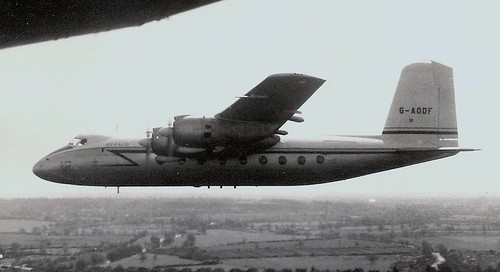
2nd prototype Handley Page "Leonides" Herald
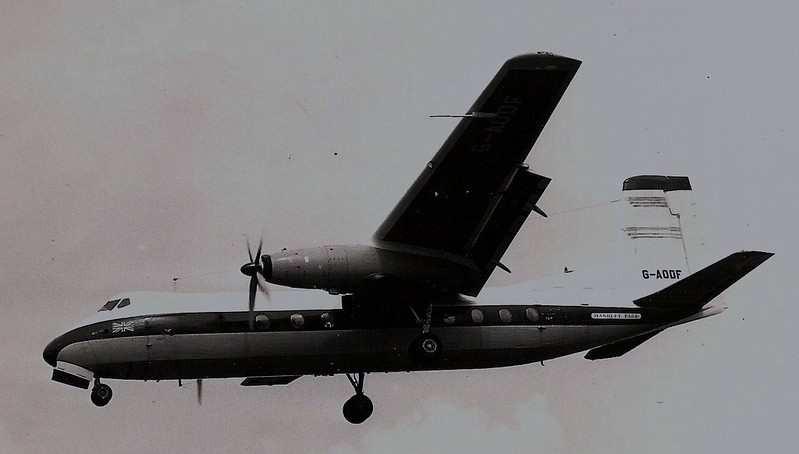
Same aircraft after conversion to a "Dart" Herald.
Dart Herald Tropical Trials (-and Tribulations!) 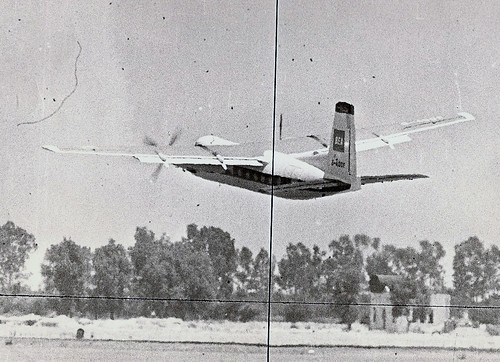

Idris Airport, Tripoli. Take off at limiting conditions with right engine feathered. Note the stationary propeller and corrective application of left rudder. Picture from F47 camera record. I was on board. It seemed much safer inside than it appeared outside!
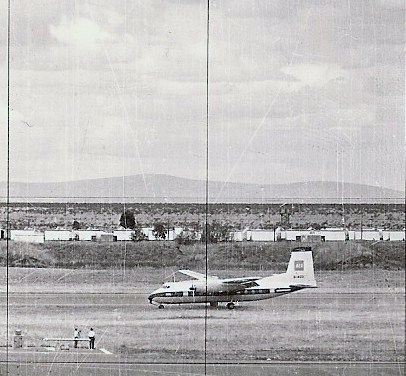
Embakasi Airport, Nairobi. Another F47 frame, another limit, this time rudder effectiveness. The aircraft ran off the side of the runway after cutting an engine at a low speed on take off. Happily no damage was done. The figures on the left are operating our portable weather station. Measuring actual meteorological conditions for each test was mandatory.
With the aim of increasing morale and enthusiasm, during my first two years with the company, Handley Page generously offered an opportunity for those interested to undertake evening piloting instruction with a flying school based at Thruxton Airfield in Wiltshire. Flying rates were subsidized but with the airfield being a distant 40 miles south/west of Reading, the flying school stepped into the breach by flying a Tiger Moth to Woodley each week which gave a reasonable window for evening flying. I was therefore able to get in some useful flying instruction.The enthusiasm thus generated was sufficient to persuade me to take part of my summer vacation at Thruxton.This proved to be very productive and after my earlier short gliding exposure with the school CCF, I was sent off on my first solo circuit after less than six hours tuition. My presence on site enabled me to consolidate my newly minted experience and by the end of my vacation I doubled my piloting experience. However this was too good to last and with the shortage of Herald orders, sadly this convenient and very cost effective arrangement came to an end.
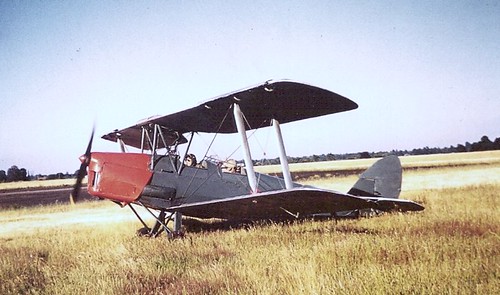
Evening flying at Woodley. I am in the rear cockpit.
Fokker F27
Avro 748
By the beginning of 1962, the Dart Herald was close to getting its Certificate of Airworthiness prior to entering revenue-earning service. I was uncomfortably aware of the uncertain future of Handley Page (Reading) and with further development unlikely I began to look elsewhere for alternative employment.
The prestigious de Havilland Company (-my favourite constructor) had just announced its entry into the fledgling world of executive or business jets with a small twin-engined design, the DH 125 or "Jet Dragon" which had just made its first flight. I found this a very exciting opportunity and wrote an unsolicited application to the company HQ at Hatfield in Hertfordshire. I received an invitation to attend an interview and in due course accordingly presented myself for interrogation. This was a big deal as with over five years experience with HP (Reading) "at the sharp end" including 250 hours of Herald test flying, I would not be assessed as a total novice but would be expected to possess some marketable skills and demonstrate them.To my delight I was offered the position of Flight Development Engineer and shortly thereafter terminated my employment with Handley Page.
To complete the story, the Dart Herald programme prevailed and was finally successful in making 50 sales -a long way from break even. The F27 went on to make nearly 600 sales whilst the 748 managed 380. All in all the Dart Herald performed well in service, the last flight being in 1991 after a total service life of nearly 30 years. Shortly after my departure the Woodley company ceased operation and all activities were concentrated at the Handley Page HQ at Radlett in Hertfordshire, a mere 10 miles or so from Hatfield.
First prototype DH 125 at its public debut at the 1962 Farnborough Air Show.
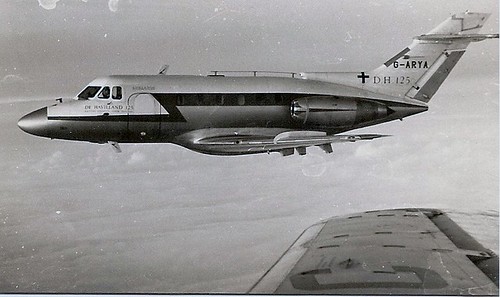
The first prototype de Havilland 125 first flew in August 1962 and a month later made its public debut at the Farnborough Airshow. I joined shortly thereafter. My introduction to the de Havilland 125 was swift. Within two weeks of arriving I took my first flight. Later, after some initial experience I was exposed to one of the most appealing parts of the job. The two person aircraft crew consisted of one pilot and one other company approved person. Since this would be a Flight Development Engineer, consequently over 200 hours of my total of 400 hours flying in the type would be from the second pilot's seat of the 1st prototype, G-ARYA plus another 200 on later versions.. It was only on international flights outside the United kingdom that two pilots were mandated. The normal on-board complement was actually three persons, the third being an Instrumentation Engineer whose function was to operate the sizeable complement of flight test equipment.
Below: Flight testing soon put paid to its neat and tidy appearance. Picture taken from the third prototype G-ARYC showing stall development wool tufts on the wing.

The aircraft was great fun to fly in. Powered by two Bristol Siddeley Viper engines, it fairly ripped off the ground. Its performance was similar to that of a first generation fighter! However, it possessed some very serious faults. The "mission statement" of the design organisation was to make a cheap, high-performance executive/business/VIP transport possessing a travelling environment -albeit smaller, as good or better than the first class cabin of regular airliners. Early tests confirmed that whilst reasonably cheap, its cruise performance was well below estimates. Indeed such was the consternation among the company hierarchy, it was decided to drop its "Jet Dragon" handle before the wiseacres of the aviation firmament renamed it Jet Drag-on!
The reasons were easy to see. The surface finish was poor with lots of mushroom headed rivets, and overlapping skin sections. The cabin noise at high level cruise conditions was appalling. In addition the controls and handling were all unacceptable. Consequently a great deal of midnight oil was burned to provide answers to problems which were potentially terminal to the project.
It was here that the very nature of the project provided solutions. The company's primary effort and that of the heavy-hitters was concentrated on the Trident airliner. The 125 had a small intensely dedicated team which (-thank heaven) was left largely to its own devices. The cooperation between the flight development and design team was exemplary. In these departments there were probably no more than 25 engineers involved on the entire project. Due to its size, it was easy to keep everyone appraised of the current situation. Indeed such was the esprit de corps of the team that when the normal workday had finished it was by no means unusual to reassemble in the "Stonehouse" pub, just across the A1 from the main gate. Here in the social atmosphere provided, not only were several knotty problems discussed informally, the ties between the team became closer. It was not dissimilar to the concept of the Lockheed "Skunk Works" Eventually after a year's concentrated effort and by virtue of many modifications the little aircraft was dragged kicking and screaming into the world of acceptability.
As had been was case with the Dart Herald, the "Hot and High -Hot and Low" combination Tropical Trials required a visit to Africa. The "High" portion meant a welcome return to Nairobi, but for the "Low" portion, Khartoum, Sudan was chosen. Apart from a distressing stomach bug that pole-axed most of the team, the venue on the Nile was satisfactory and its history fascinating to explore.
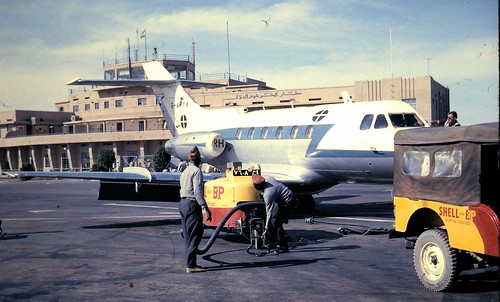
Refuelling between sorties at Khartoum.
One significant task now remained before full certification. This was Route Proving' where the aircraft was required to complete about 100 hours of intensive flying away from Hatfield during which time it would be operated by no specialized personnel. It required that 90% of the flying to be done by non-125 company pilots plus engineers who had only recently completed the 125 conversion course. For this the fourth prototype, G-SEC the configuration of which was typical of production aircraft was employed. During the flying, all the various systems would be operated numerous times both in normal and emergency modes. This task was my responsibility. I spent most days flying around Europe. A typical day would comprise a departure from Luton Airport to Madrid, Rome and Zurich. Things went very well save one Saturday evening arriving at Nice when something struck the aircraft on approach. Since it could have been ingested by an engine we had to remain overnight until engine specialists who were flown out had time to inspect the engine. So there we were -stranded for the weekend in Nice. What an imposition! eventually after its completion, a mountain of information required collating and a report written for the Aircraft Registration Board (ARB). Soon thereafter the 125 was granted its Certificate of Airworthiness and and entered service.
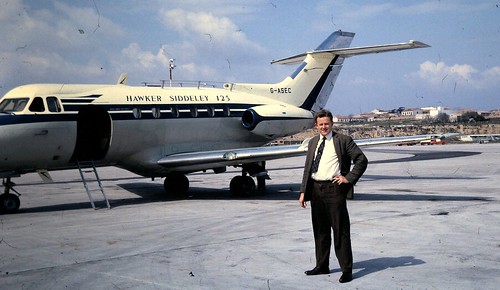
Route proving: Lunch stop at Barajas airport, Madrid
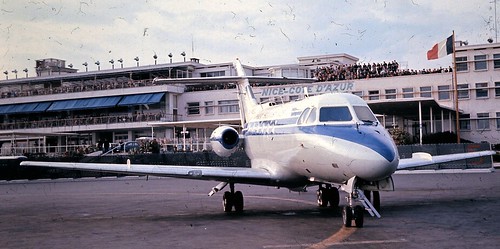 Route proving: The unscheduled stop at Nice. Tough job but someone's gotta do it!
Route proving: The unscheduled stop at Nice. Tough job but someone's gotta do it!All went well although the Trident team comprising the Chief Test Pilot, John Cunningham and his number two Peter Bugge plus about twenty others, completely eclipsed our four 125 souls, comprising a pilot, flight development engineer, instrument specialist and a ground engineer.
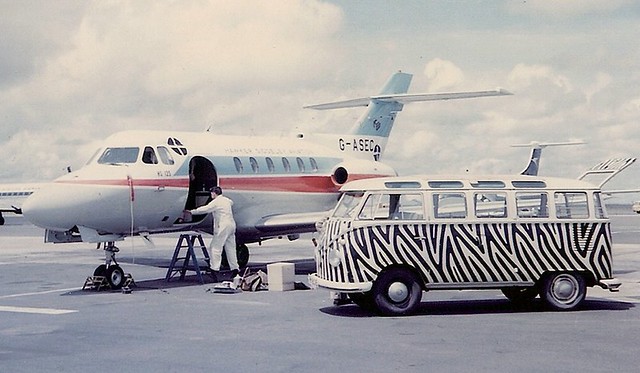
G-ASEC at Nairobi sporting its new colour scheme which was not to my liking! In the background is the tail of a VC10 which had just entered service.
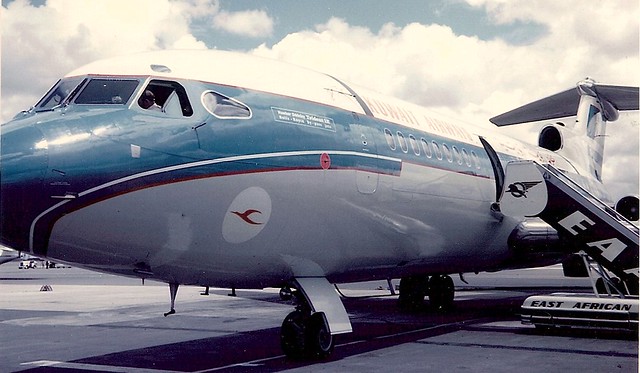
The Trident 1E, with John Cunningham et al arrives in Nairobi
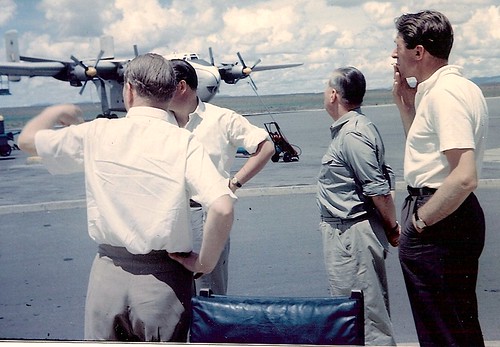
From left, John Cunningham; Dennis Murrin (ARB); 125 pilot Geoffrey Pike and Deputy Chief test pilot, Peter Bugge, assess the Nairobi weather. As well as temperature, steady wind conditions were critical towards getting good, repeatable results. In the background is a Blackburn Beverley heavy transport.
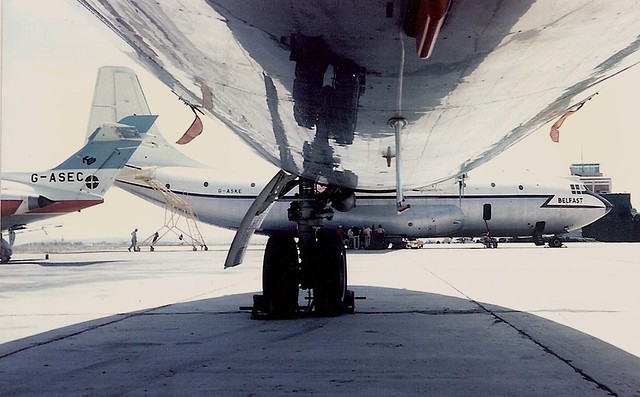
Torrejon, Madrid; View of the Short Belfast and the tail of the 125 from under the Trident fuselage. Note the sideways retracting nose gear; a feature of all Tridents

A Trident Two in BEA colours
With all current development complete on both Trident and 125, their names now prefixed by the new corporate identifier "Hawker Siddeley" there was little to do. Consequently because of my previous experience, somewhat to my disgust I was seconded to the Aerodynamics department. Initially, the possibility of a pressurized turboprop version of the popular Dove aircraft was being considered and on which project I would be closely involved, I persevered.
Anxious to retain some contact with the flying environment, I decided to join the London Gliding Club at Dunstable Downs. Apart from the long days that would be involved to maximize launch opportunities, it was a rewarding experience. At this time, unlike my previous experience at Booker, two-seat Slingsby T21 two-seaters were available for initial training. Since the airfield is situated in undulating country adjacent to the Chiltern Escarpment, careful circuit planning is vital to avoid an unscheduled landing, particularly into the adjacent Whipsnade Zoo! I quickly went solo and qualified for B and C Certificates. I had reached Bronze C status before other events took priority.
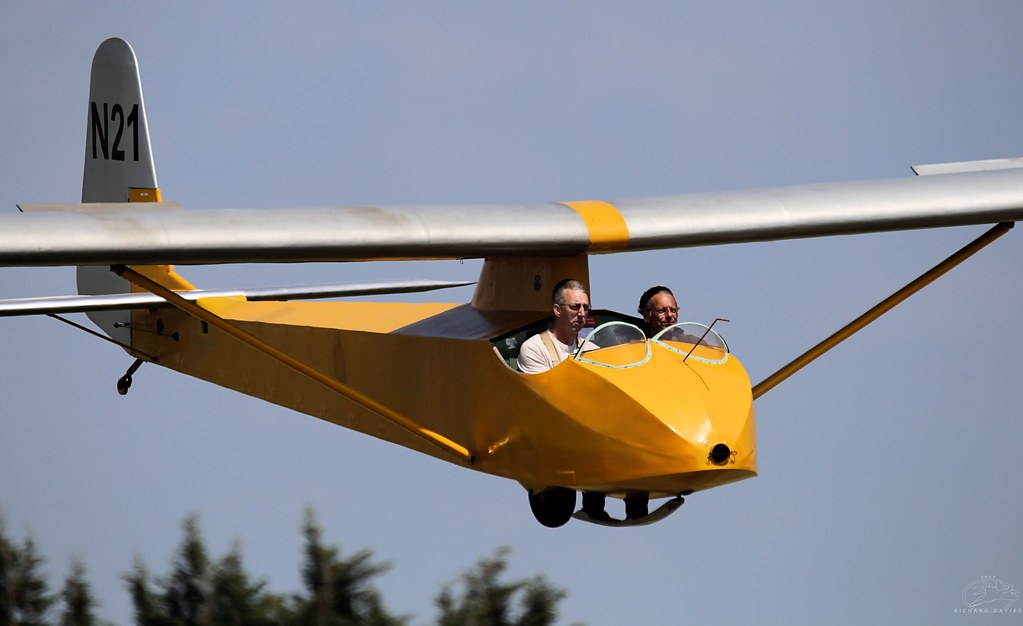 The ubiquitous T21 two-seater, mainstay of a large number of gliding clubs for many years up to and including the present day. See recent picture in Part Three.
The ubiquitous T21 two-seater, mainstay of a large number of gliding clubs for many years up to and including the present day. See recent picture in Part Three.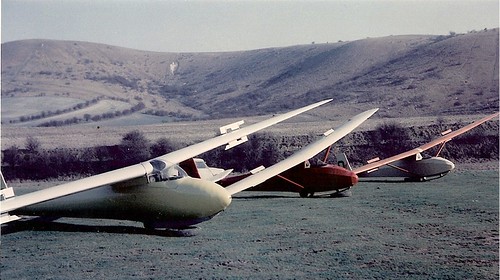
Dunstable Downs. Most of my early solo gliding was done on the two Slingsby Prefects (centre and right).
After a year or so it became apparent that the turboprop Dove would not happen. Coincidentally, my erstwhile employers Handley Page, who had been closely watching developments at Hatfield, announced their own small 18 seat pressurized version with the same specification as the turboprop Dove and named "Jetstream". Its potential seemed virtually unlimited in the burgeoning commuter market and it had already received 160 conditional orders from the USA alone. The attractive little aircraft seemed to be having the world knocking on the doors of Handley Page.Impatient to return to the Flight Test environment, I applied for and was offered a position of Flight Test Engineer at their Radlett plant barely ten miles from Hatfield. Happily this was not the end of my involvement with the 125 although the occasion would be several years hence..
The next 18 months with Handley Page were without doubt the most frustrating of my flight test career. I had imagined that my recent ten years experience in the development of civilly-certificated aircraft would be of value. I couldn't wait to utilize this in any and all ways I could to help. Sadly, did not work out. Flight Test engineers at Handley Page Radlett were viewed as airborne clerks, unwanted but unavoidable, No technical input was expected from them. During flights, design office instructions were executed without question and notated on suitable forms. All decisions were made by a hidebound design office headed by an individual whose background had been exclusively military. Technology transfer from the Victor jet bomber to an 18 seat commuter turboprop was totally inappropriate. Sadly almost all of the civil-experienced Dart Herald team who transferred from Woodley had either left or retired.
The entire programme was a shambles. Of particular concern was weight "control" which had been hopelessly ignored. Also the two Turbomeca Astazou engines were problematic. Relations with the Air Registration Board who were very willing to provide full assistance as and when required, bordered on the hostile. Since I had always enjoyed a cordial and respectful relationship with them and my recent ten years activity on two types had brought me into close contact with those involved. In fact they had become good friends. In consequence being familiar with the problems and possible solutions, I was regarded as the sole intermediary between the ARB and the company with whom they could communicate. I felt somewhat uncomfortable and even a tad disloyal at having to deal in a clandestine manner to update the ARB on the latest debacle. I attempted to discuss the situation with the Chief Designer but was imperiously brushed aside with the comment that "this is a private venture. It has nothing to do with the Government. We will do exactly as we wish!"
However, there was one bright spark in the dismal situation. With unusual foresight it was decided to position the aircraft for the upcoming winter months at the pleasant city of Pau in South-West France where the weather would be better, but in particular would be close to the engine manufacturers at nearby Tarbes. An additional benefit was that the entire team would be (at least partially) removed from suffocating design office interference.
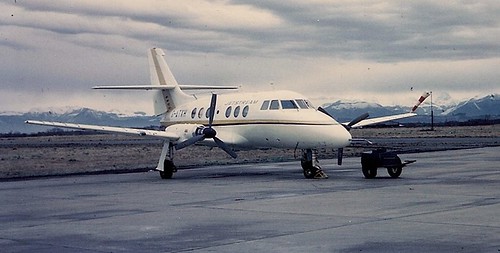
The first prototype Jetstream on the tarmac at Pau with the Pyrenees behind.
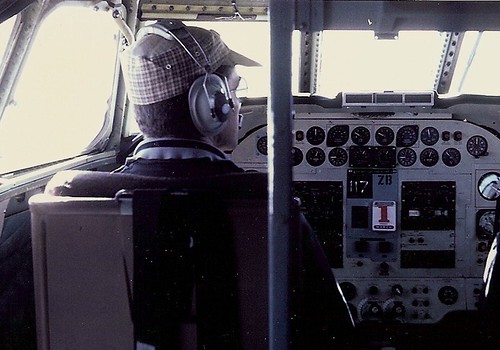
Neil Williams at the controls of the Jetstream at Pau. This was my final flight. (See image below).
Despite this, the programme continued to flag. Another problem to arise concerned the stalling characteristics which were unacceptable. The remedial instructions received from Radlett, were ludicrous, totally ineffective and potentially dangerous, particularly when the solution was obvious. Fortunately one of the pilots was Neil Williams, who was the current European aerobatic champion. On occasions he was forced to show his mettle in recovering the aircraft from dangerous post-stall situations where the aircraft was sometimes inverted! Finally the ARB insisted that the aircraft was fitted with a stick-pusher. This artificially pushed the nose down before the "actual" stall speed was reached. This was not only expensive and time consuming, but it had a negative affect in increasing take off and landing speeds, and hence take-of and landing distances. 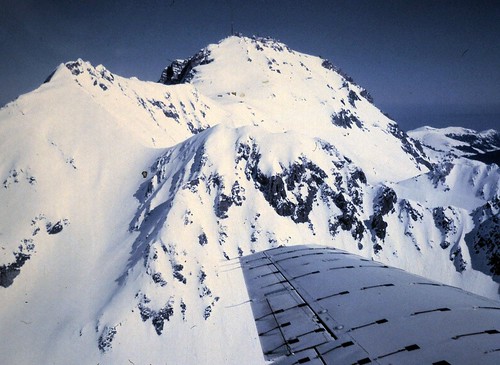
To provide me with a visual memoir, Neil took me on a magnificent tour through the mountains. The wing tufts had been mounted in such a ridiculous fashion that they themselves affected the stall characteristics!
Eventually my exasperation got the better of me. Prior to moving to Pau, I had been for an "preemptive" interview at Bristol with the British Aircraft Corporation and had been offered a good position on the Concorde flight test programme. Since Concorde was not due to fly for about a year, I was given the opportunity to remain in useful(?) employment with Handley Page to gain additional experience(!) and then join BAC when I was ready. After three months at Pau I resigned, returned to England and in due course reported to the Concorde's base at Filton.
The one positive activity that stood out whilst at Handley Page was that I decided to bite the bullet, joined the Luton Flying Club and obtained my Private Pilots Licence. Amazingly, all my previous flying including gliding was accepted thus reducing the hours(and cost!) of the course.
The Jetstream project, initially such a potential winner had now, hopelessly managed, lost its way and with, it all of the early orders. Eventually it bankrupted the once great Handley Page company which finally closed its doors in 1970.
A full ten years later, the newly amalgamated British Aerospace (BAe) realized its potential and Scottish Aviation were tasked with making some sense out of the basically sound design. Re-engined with Garrett TPE 331 engines and updated, the first "Jetstream 31" flew in 1980 and went on to realize something of its initial potential. A total of 386 Jetstreams were ultimately delivered. A stretched version, the Jetstream 41 added a further 100 sales to the total. Even to this day the memory of the unnecessary flight development debacle still raises my hackles!
A splendid American registered Jetstream 31.
Concorde 002 under construction in the Brabazon hangar.
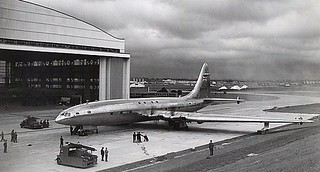

1949
This enormous hangar had been originally built to house the whitest of "White Elephants"
the Bristol Brabazon
the Bristol Brabazon
1969
Twenty years later; same location very
different aircraft. Roll out of Concorde
prototype G-BSST -commonly referred to as
Double-Oh-Two
There were some early problems with my job definition. Incredibly I found myself dealing with computer savvy academicians who had no flying background or practical experience in Flight Testing. However, ultimately this was all to my advantage. I soon discovered that little had been done of a practical nature to physically prepare for the enormous task that lay ahead. I therefore took it upon myself and with not only with the full cooperation of my immediate superiors but the supportive encouragement of the Design Office, to produce the entire Performance Flight Test Programme, a document of well over 100 pages. What a profound difference from my previous employers! Apart from the bureaucratic nature of the project, due mainly to the government involvement of the two participant nations, British and French, things went surprisingly well. My Performance "magnum opus" required no less than 9 signatures before it was published!
Concorde G-BSST made its first flight from Filton on April 9th 1969, just a month after its French counterpart and landed at RAF Fairford where it would be based for the entire development programme. My initial concerns related to the lack of practical experience among the staff were soon relieved as a steady stream of new faces joined the team from the shrinking number of British aerospace companies, particularly from the BAC facilities at Weybridge and Wisley in Surrey.
Concorde G-BSST lifts off on its maiden flight from Filton on April 9th, 1969
For a few months there was some slight hostility between the old guard and the newcomers as all strived to establish their territorial boundaries. However, this eventually subsided, the old guard returned to Filton and their algorithms, and the remainder soon melded into what was to become arguably the finest Flight Test organisation in the world. Fairford, being located in Gloucestershire and the Cotswold's provided a pleasant, bucolic atmosphere in which to work and play, the latter evidenced by the greatly increased cycling of the cash drawers of the many public houses!
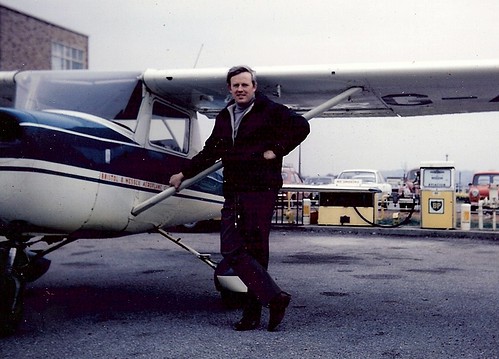
Just prior to departing in a Cessna 150 with one of my "victims" for a trip around the area.
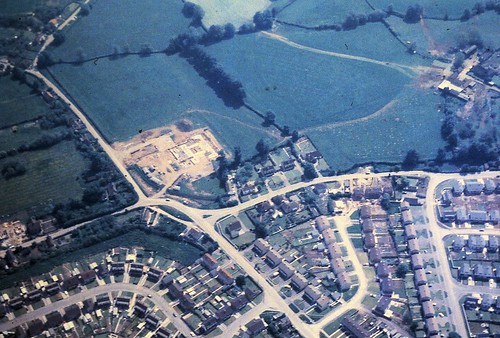
Thornbury; I shot that I took from a Cessna 150. The Bird residence is on the street which runs horizontally across the picture to the new construction. Our house is above the road, the third house from the right in front of the larger of the three trees.
The Concorde itself proved to be something of a revelation. Its serviceability was outstanding and apart from a few minor problems acquitted itself amazingly well. In defiance of the naysayers, in 1972 it undertook a month long tour of the Far East covering twelve counties followed by an appearance at the Farnborough International Airshow with no significant problems.
At this time a colleague and myself undertook a most interesting fact-finding mission to Dubai, Bahrain and Shiraz in Iran to identify suitable locations for Tropical Trials. However, political considerations (the precise reasons were never revealed) resulted in a decision to use Johannesburg and Madrid instead. As for the two of us, we now had some interesting new stamps in our passports
In January 1973 aboard a comfortable RAF Britannia, the test team travelled to the Transvaal where it remained for six weeks. As was by now expected, the Concorde behaved itself and everything was completed on schedule, as was the three week duration of the subsequent Madrid portion. On this latter occasion, I flew out on Concorde and returned on an Armstrong Whitworth Argosy twin-boomed freighter which, with its four Rolls Royce Darts and bulbous nose with radome, was affectionately known as "The Whistling Tit"!
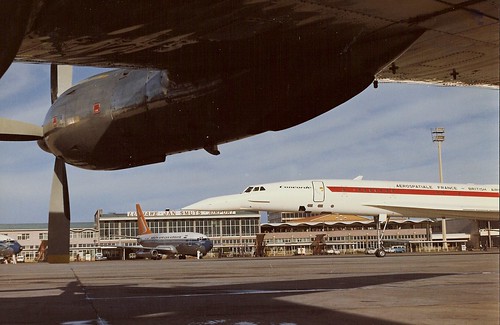
The new kid on the block! G-BSST arrives in Johannesburg for Tropical Trials.
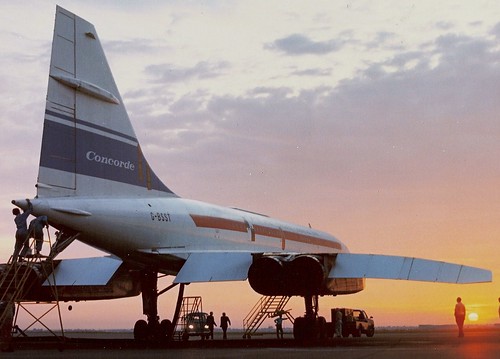
Johannesburg 6 am. Early morning flights were the norm to capitalize on still-air conditions.
 Johannesburg. A mental health break as the aircraft is checked over between flights!
Johannesburg. A mental health break as the aircraft is checked over between flights!
 Johannesburg. A mental health break as the aircraft is checked over between flights!
Johannesburg. A mental health break as the aircraft is checked over between flights!
-and for the "Low and Hot" portion at Madrid, a "Whistling Tit" did the honours!
Without doubt the 9 weeks of Concorde Tropical Trials were the high spot of my Flight Test career. As I have always maintained, a small cohesive group of enthusiastic, competent people operating away from the corporate constraints of home base is more efficient and productive. In the case of Concorde, the Johannesburg team did include several self-important heavy hitters who contributed little more than their egos, but for Madrid this was nipped in the bud by a pragmatic, no-nonsense Scotsman Flight Test Director. Madrid with less people and everyone having a valid job definition, was the epitome of the way things should be done. The test equipment included a portable computer which had proved its effectiveness at Johannesburg. Now, well up the learning curve it was possible to conduct an analysis of each flight's records before the aircraft was released for its next sortie. This ensured that the entire programme had been fully and satisfactorily completed, recorded and even analysed before returning to England. This was a huge advance. Previously, post-trials activity had involved several weeks of intensive effort to produce a definitive report, and sadly at times revealed shortcomings either in the quality of the data or even worse in the tests themselves.
Although my previous sojourn at Hatfield had been a happy one, this was at least partially due to the extra-mural activities available. At Madrid, with the team staying in the city centre, no matter what had occurred during work hours at Torrejon, no matter how long the days, with Madrid being virtually a 24 hour city, extra-mural activities could be as "extra" as the stamina of the participants allowed!
Shortly after our return to Fairford, my euphoria was given another boost when the above referenced dour Scotsman summoned me to his office, congratulated me on my efforts and announced that I had been promoted to Management Staff status. On the face of it, things couldn't have been much better. Here I was living in a new house situated in a pleasant country town with a growing family in a particularly attractive part of England -with a good job that paid well. As sustaining my private flying was so expensive, I reluctantly traded horizontal wings for vertical and took up sailing -particularly dinghy racing. After a very wet initial year where I seemed to spend more time in the water than aboard the boat, I finally got the knack and was now enjoying significant success. All this took place at the Cotswold Water Park, a mere 10km or so from Fairford. Overall it was a most desirable family environment.
Unfortunately behind all this, inevitable feelings of uncertainty arose, as they had in my previous appointments. There would be no further Concordes after the delivery of 16 to British Airways and Air France respectively. It was clear that our lotus-eating existence at Fairford would be of limited duration. However, this time there were no new flight testing opportunities at all -at least in the short term. Unless I could find other employment quickly, the downsizing of BAC was inevitable and with it an increasing number would be forced onto the streets. Competition for employment elsewhere would become increasingly fierce. In fact the trickle had already begun.
There was one possible light on the horizon. Hawker Siddeley Hatfield, my old stomping ground announced their intention to build a small four-engine airliner to be called the H.S. 146 due to make its first flight in about 18 months. I had fully accepted that I needed a change in job definition to survive. During my previous incumbency at Hatfield I had been asked if I had ever considered moving into the Sales and Marketing firmament. This presented me with an enormous opportunity should I be fortunate enough to grasp it. I wrote to the company, attended an interview, met some of my old colleagues, discovered that I had not burned any bridges and was delighted to be offered a position of Senior Sales Engineer on the new 146 project.
My relief was tinged with sadness as we sold our less than three year old house, my beloved sailing dinghy and returned to Hertfordshire to take up a completely new challenge. I had enjoyed the last 17 years but it was time to explore "fresh fields and pastures new". At the time I could have no notion of how fresh the fields would be or how new the pastures! The aircraft featured in Part Two would take me far away from our familial estate.
----------------------------------------------------------------------------
Part Two: Plane Saleing!
For an airliner, its configuration was unorthodox. Its four engines slung under a high wing and the main landing gear mounted in "blisters" in the fuselage were not the norm. The initial 146 would be as shown in the three view drawing below. However future "stretched" versions would be offered. The seating arrangements would permit 70-100 passengers.
Hawker Siddeley Hatfield had physically changed little since my last sojourn eight years earlier. With a brand new project in the offing and the addition of keen new blood, the Sales Office was very bullish and eager to get on with it. At the time there was no metal evidence of the 146, its existence being confined to paper representations, plus small attractive models that were destined as colorful desk-top reminders to prospective purchasers -and last but by no means last a full scale wooden mock-up which included an impressive furnished cabin.

A three view diagram showing the physical features of the 70-80 seat HS 146-100. A stretched version Series-200, to accommodate up to 100 passengers was also planned.
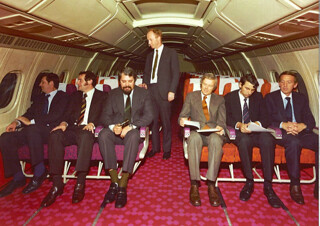
The impressive full sized 146 cabin mock-up. At least one of the individuals shown would be present at all airline sales presentations. This was to address any allegations that small people had been used to exaggerate the size of the cabin!
Despite, or more likely because of the lack of an aircraft, the next three months involved some fairly intensive training. There were several internal company sessions plus another week-long course presented by an outside organisation specializing in the training of executives. Finally, I was invited to attend a live-in Royal Aeronautical Society course on Air Transportation at the seat of learning itself, Oxford; and the ancient precincts of St Edmund Hall in particular. Its three-week duration was demanding and exhausting. Most days were of twelve hours duration from 9am to 9pm. Since it was hands on and self-participatory, there was nowhere to hide. At the end of the day there was scarcely time to proceed to the nearest ale house for restorative therapy! At weekends there was homework!
Nevertheless, the whole period, despite its arduous nature, certainly got me up to speed and was highly commendable. At its conclusion, I was happy to get back to the office for a rest. Some chance!
I was now considered competent to create airline-specific technical sales studies and subsequently make presentations to airlines. These could be quite complex, comprised of data essential to enable prospective customers objectively evaluate the economic and operational benefits of the 146 operating on their routes. Accompanying the Regional Sales Manager, Europe I made a couple of visits to France and explained my studies full of newly acquired wisdom to several airlines.
I was then tasked with "entertaining" a group of visiting Australian airline people including shepherding them to and from the Farnborough Air Show. This proved to be an easy assignment as not only were they very "personable" but having seated them in the Hawker Siddeley Chalet with easy assess to the beer, little further input from me was expected or desired -unless I joined them in sampling libations.
At the conclusion of the Air Show and having seen off my Australian visitors, another even more exciting prospect arose. I was to make a 17 day visit to South America in the company of the Region Sales Manager, South America, Harry Rhoades during which presentations would be made to all the major airlines in Brazil, Argentina and Uruguay.
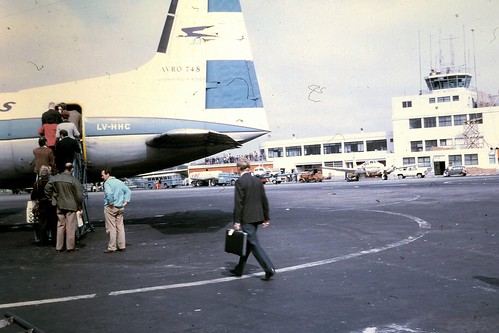
Buenos Aires. Harry Rhoades strides towards an earlier nemesis, an Avro 748 of Aerolineas Argentinas, which would take us to our final destination in South America -Montevideo, Uruguay. At this time, we had no indication of the shock that would be waiting for us on our return to Hatfield.
Things went fairly well and genuine enthusiasm was generated among the airlines visited. Having completed our mission in Uruguay, we flew back to England feeling smug and self-satisfied with ourselves. However this didn't last long as we were met at Heath Row by a colleague who instructed us to return home and not to report to work until the following Thursday. With a gnawing sensation in our nether-extremities, we reported to Hatfield and were informed that all work on the 146 would cease. Government involvement in the project had been put on hold due to the current oil crisis and its adverse effect on airline economics!
To be fair, the company made substantial efforts to relocate everyone, some of whom like myself had only recently located. As far as I was concerned, there was talk of exporting me to Airbus Industries in Toulouse. However, my knowledge was restricted in airliner sales expertise. Consequently I was located in the 125 Sales Engineering office. This was a relief from a job security standpoint, but the tasks involved were less than challenging with all studies being of the "cookie-cutter" variety -at times requiring little more than technical form-filling. Happily this was of short duration as I was advised by the Sales hierarchy that I was being considered for promotion to full Salesman status. In the meantime I was charged with making courtesy visits to 125 operators in Southern England to become familiar to dealing with customers one-on-one.
This activity was of surprisingly short duration as after three months, to my astonishment, I was offered the position of Sales Executive, Southern Africa! The result was that a few weeks thereafter, and a little over two years since my previous visit with Concorde, I took up business residence in a dusty and shabby office in Loveday St. Johannesburg. This was the location of Hawker Siddeley International. It was manned by a group of retired Air Force officers plus one other non military intruder. My home for the next two years would be the Rand International in Bree St. in the centre of Johennesburg.
It did not take long to discover that South Africa was, due to apartheid, a backwater of things aeronautical. I was immediately besieged by the organizers of what was to be the first International Air Show ever held in South Africa. I was assured that it would be attended by aviation luminaries such as Sheila Scott, who had famously carried out a solo flight around the world in a single engined Piper Comanche, and also the celebrated Bob Hoover who was widely regarded as the best air show demonstration pilot in the world. The organizers begged, cajoled and pleaded for me to get a 125 to attend. I sent a request to Hatfield, giving the assurance that whilst in South Africa, in addition to its show routine it would be made available preference given to any prospective customer demonstrations. Response was immediate and positive. The new 125-600 demonstrator would be made available. That was easy!
Next came a totally unexpected blast from the past. I heard that a Concorde was at Jan Smuts Airport "doing some tests". I investigated further and eventually tracked down the team and was invited to visit the aircraft. It was doing some final route proving before entering service with British Airways. The airport people had made a bit of a show of the visit and positioned the aircraft next to a recently completed, beautifully restored Spitfire 1X and a new Boeing 747SP which had just been delivered. It was an unexpected pleasure to meet up with my flight test colleagues who were naturally apoplectic to see me there. The atmosphere among them was somewhat glum as they knew that this trip would be their last "kick of the can" and they collectedly expressed some envy at my escape and new circumstances. I tried not to be too smug.

What a surprise! Concorde at Jan Smuts airport just prior to entering airline service. In the foreground is a beautifully restored Spitfire 1X and behind a recently delivered Boeing 747SP.
It was only after viewing the proposed Air Show programme that I understood the reason for the organisers' high anxiety. The remainder of the flying demonstrations would be provided by a range of locally registered light aircraft, supplemented by displays by the South African Air Force flying oldish if not geriatric aircraft. We, as the sole exhibitor of a current state of the art product from a major manufacturer would be the star of the show! It was rather like being persuaded to attend a dinner and to find out that you are the main course!
The show itself went off without incident. For the populace any connection with the outside world was eagerly grasped. I was treated like a celebrity and even did two radio interviews. Astonishingly television was still a thing of the future. Being held at Lanseria, about 60 km outside Johannesburg, attendance during the first two or three days of its ludicrously long 7 days was pathetic. The colourful white, yellow and white 125 always had a crowd around it. I was pleased to have the opportunity to meet Bob Hoover and Sheila Scott. In fact Sheila and I stayed at the same hotel and had breakfast together a couple of times. However, on one of the show days, I was required to discharge my obligations to Hawker Siddeley. A local business tycoon was seriously interested in purchasing an aircraft. I invited him to use the aircraft for one of his frequent business trips to Mbabane, the capital of Swaziland. He agreed and somewhat to the disgust of the air show people we "borrowed" the aircraft for a day. Since the business meeting was a full day affair, our prospective customer gave us a car for the day which was fully utilized in exploring the fascinating Swazi countryside.
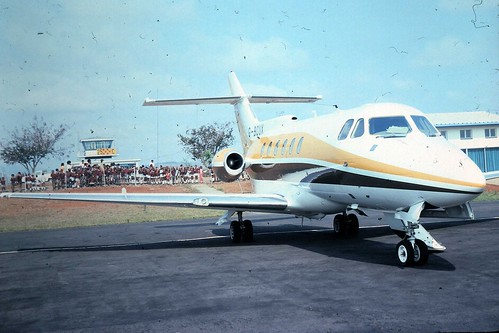
Mbabane Airport, Swaziland. Behind the fence the children from the adjacent school were very excited to see this colorful new bird.
On our return to Lanseria, our customer "complained" that he was back two hours earlier than usual and now had nothing to do! He did actually buy a 125, albeit a used one, which he would keep at Lanseria. Unfortunately, shortly after delivery, his pilot attempted to move the aircraft by allowing gravity to roll the aircraft forward on the sloping tarmac. Unbelievably, he didn't check the status of the brake accumulator first. It was empty; consequently there was no brake pressure available and the newly acquired owner's treasured possession "taxied" itself across the tarmac into a ditch severely damaging the entry door and nose gear assembly. Amazingly this event did us more good than harm. Hatfield sent out a team overnight and the aircraft was flying again within a week. Quite an endorsement for customer service excellence! Remarkably, the pilot didn't lose his job -just his reputation.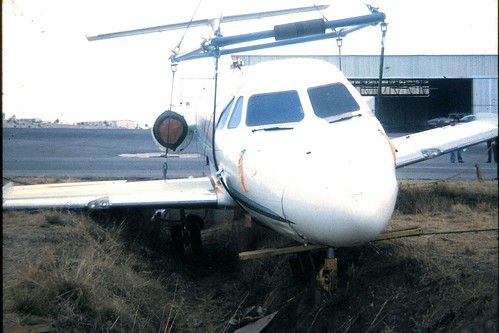
A novel version of "aircraft ditching" -without water!
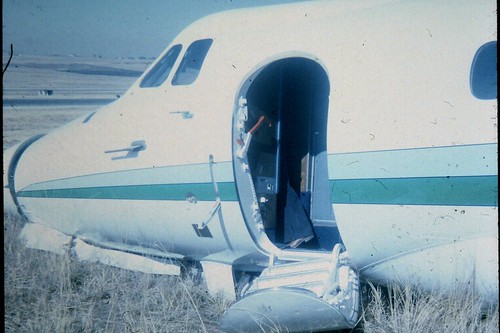
There was severe damage to entry door, nose gear and nose cone. Thanks to superb customer support from Hatfield, the 125 was as good as new within a week of the accident!
After the Air Show I was surprised to be constantly in demand as an "international jet setter" (-from England no less!), to attend the best and booziest parties. The consumption of alcohol at these functions was awe inspiring. To snare someone -anyone from overseas was the aim of the socially conscious hosts. The fact that aviation was involved gave the hosts additional street cred.
Over the next two years I made a point of getting to know as much as possible about the region. I made a few trips to beautiful Cape Town and Gaborone, Botswana. I also spent a week in Zambia visiting the military and every aviation concern I could find. Happily whilst there, I was fortunate to be able to share a car for an unforgettable visit to Victoria Falls and its environs.

Cape Town from the co-pilot's seat in a "Cessna Golden Eagle"
I did most of the flying -which was a bit demanding after a four year lay off!
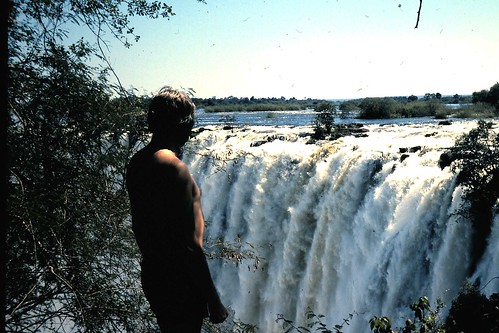
No explanatory comment necessary! Not just the Falls, but the course of the Zambezi before and after the falls is spectacular.
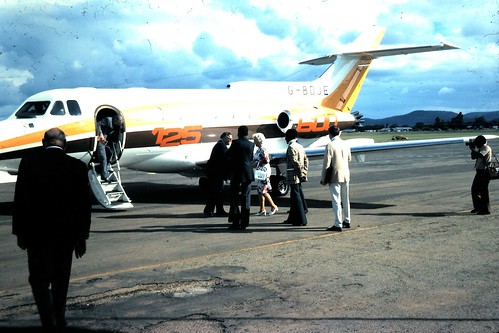
Ivor Richards (centre) is greeted by a lady whom I assume was the British Ambassador to Botswana.
By 1976 there were seven 125's in South Africa including an new Series 600 delivered to Rio Tinto. For some time it had become increasingly clear that the chance of future sales were unlikely until apartheid had run its course. Elsewhere in Southern Africa, apart from possible Governmental applications, prospects were almost non-existent. My Southern African duties involved little more than updating the airlines on the status of the 146 but this task took little time and effort! Despite this, the company was not at all phased and felt the need for a permanent corporate presence since they had little faith in the geriatric Air Force incumbents of Loveday Street. My jet-setter role was becoming tedious and I really had little interest in becoming the company mouthpiece. By the following year I was became increasingly despondent at this, particularly with my lengthy absences from a growing family. Every so often I would return home for a couple of weeks, only to return once more to my arid sales desert.
At this time the aviation industry in Britain underwent a further consolidation. Virtually all remaining companies which had survived the knackers yard became members of the new British Aerospace (BAe for short). Once again I considered my position. Even with the amalgamation, the aviation situation in Britain was that there were no situations. I did not fancy a move to the US, and after reviewing the Commonwealth, Canada seemed the best bet as they had a brand new airliner, the Dash 7 which had just received its Type Approval and was now looking for buyers. Since the Paris Air Show was coming up and knowing that I would be there, I wrote to de Havilland Canada, offered my services, and to save expense, offered to present myself for inspection and interrogation at the show. As they say "to cut to the chase". This worked out well, I was suitably scrutinized by the V.P. Sales and Marketing inside the cabin of a Dash 7 which was being demonstrated at the show. He offered me a job as a Regional Sales Manager. My only condition was that I did not wish to be separated from my family for long periods and it was agreed that my region would be within North America. Despite the name, de Havilland (Canada) was long separated from the English parent company and was now owned by the Canadian Government
The time scale through the immigration procedures was far longer than we expected and I continued to reside in South Africa as before. Being gluttons for punishment, another Air Show at Lanseria was being planned and having survived the first, I was now regarded a somewhat of an authority on the subject and found myself sucked into the process even more than before.
As there had been the merest sniff of a sales opportunity from the Mozambique Government, my request for a 125 was not only positively received, but the aircraft would be latest development, the Series 700, with many upgrades including a totally new power plant, the Garrett TF731 turbofan which increased its range by close to 50%!
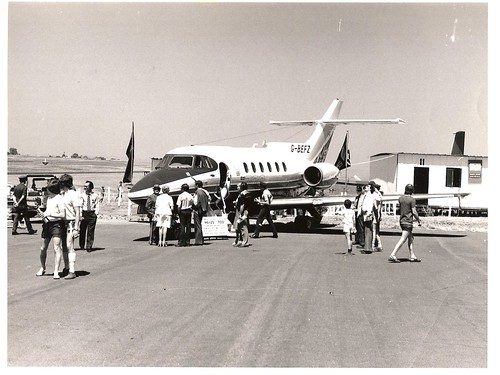
There were no "star" contributors this year. However, there was one forgettable performance from the bizzare looking three-engine Britten Normal Trislander. During its display, the pilot completely misjudged his "recovery" from a manouevre, and struck the runway with an enormous clang. Amazingly he began to climb away leaving a large cloud of dust behind! On the runway behind him was an assortment of components including an engine and the landing gear! The second wing-mounted engine was hanging vertically from the wing. The climb out was made using the third fin-mounted engine which continued to function for about ten seconds after which the remnants of the Trislander made a rapid descent hitting the ground beyond the runway creating an even bigger cloud. Amazingly there were no fatalities alfhough the two crew members sustained serious back injuries, from which happily they would both recover.
At this time the aviation industry in Britain underwent a further consolidation. Virtually all remaining companies which had survived the knackers yard became members of the new British Aerospace (BAe for short). Once again I considered my position. Even with the amalgamation, the aviation situation in Britain was that there were no situations. I did not fancy a move to the US, and after reviewing the Commonwealth, Canada seemed the best bet as they had a brand new airliner, the Dash 7 which had just received its Type Approval and was now looking for buyers. Since the Paris Air Show was coming up and knowing that I would be there, I wrote to de Havilland Canada, offered my services, and to save expense, offered to present myself for inspection and interrogation at the show. As they say "to cut to the chase". This worked out well, I was suitably scrutinized by the V.P. Sales and Marketing inside the cabin of a Dash 7 which was being demonstrated at the show. He offered me a job as a Regional Sales Manager. My only condition was that I did not wish to be separated from my family for long periods and it was agreed that my region would be within North America. Despite the name, de Havilland (Canada) was long separated from the English parent company and was now owned by the Canadian Government
The time scale through the immigration procedures was far longer than we expected and I continued to reside in South Africa as before. Being gluttons for punishment, another Air Show at Lanseria was being planned and having survived the first, I was now regarded a somewhat of an authority on the subject and found myself sucked into the process even more than before.
As there had been the merest sniff of a sales opportunity from the Mozambique Government, my request for a 125 was not only positively received, but the aircraft would be latest development, the Series 700, with many upgrades including a totally new power plant, the Garrett TF731 turbofan which increased its range by close to 50%!

Lanseria,1977. The new BAe 125 Series 700. Note the larger intakes for the Garrett turbo-fan engine. As is evidence, the number of spectators scarcely constituted a "crowd". Behind, the somewhat austere building number 11, is the British Aerospace chalet.
There were no "star" contributors this year. However, there was one forgettable performance from the bizzare looking three-engine Britten Normal Trislander. During its display, the pilot completely misjudged his "recovery" from a manouevre, and struck the runway with an enormous clang. Amazingly he began to climb away leaving a large cloud of dust behind! On the runway behind him was an assortment of components including an engine and the landing gear! The second wing-mounted engine was hanging vertically from the wing. The climb out was made using the third fin-mounted engine which continued to function for about ten seconds after which the remnants of the Trislander made a rapid descent hitting the ground beyond the runway creating an even bigger cloud. Amazingly there were no fatalities alfhough the two crew members sustained serious back injuries, from which happily they would both recover.
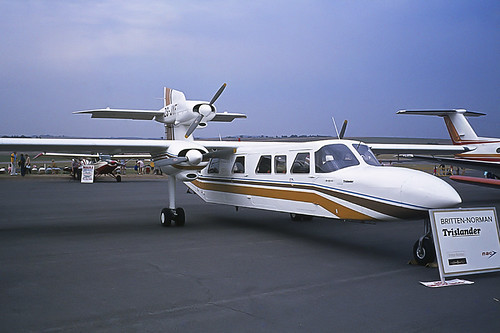
Lanseria; The pristine Britten-Norman Trilander which, not long after this picture was taken,distributed many of its component parts on the runway -including an engine and the landing gear!
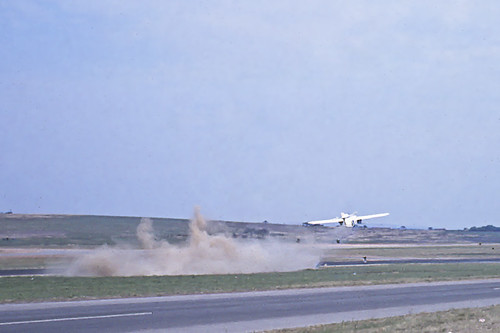
Lanseria; The Trislander, shortly after striking the runway. The main landing gear can be seen en-route between the aircraft and the runway. The detached right engine is hidden behind the dust and the other wing mounted engine is hanging vertically. Ten seconds later, the aircraft crashed - permanently.
Whilst all this excitement was taking place, I was in touch with the British Commercial Secretary in Mozambique to arrange a demonstration in Maputo for the Government. As before, we "borrowed' the aircraft from the Air Show. However following the demonstration, it was decided that the aircraft would not return to Lanseria but head for home.
The demonstration and follow up discussions went remarkably well. The Government representatives were virtually all British with airline backgrounds, everyone understood the subject and spoke the same technical and economic language. Mozambique itself was another matter. Having recently won their independence after a period of war, our visit was during a short period of peace after which hostilities of the most violent kind continued for many years. Those of Portuguese heritage were being oppressed and where possible, all their assets were being aggressively stripped. Most were just desperately trying to get out.
After the 125 departed I was left on my own with my one solitary contact at the British Embassy. I have never felt so isolated or insecure. The streets were being patrolled by armed troops, food was scarce and my hotel was a shambles. At the airport those trying to leave were being roughed up and their possessions seized. Thanks to the Embassy which was (thankfully) concerned at my predicament, I was made an honorary Vice-Consul and accompanied the actual Vice Consul who was departing this day for England with the "diplomatic bag". It was an actual linen bag with the words "On Her Britannic Majesty's Service" stenciled upon it. At the airport, so long as I maintained contact with this piece of cloth, I had no problem apart from being pushed and shoved. Others trying to board the same flight were not so lucky. Those of Portuguese origin (in effect anyone white) were being treated abominably. Those who made it onto the flight were penniless and their sole possessions were the clothes they were wearing. Others were being slapped and beaten, some being pulled out of the line and taken goodness knows where. I was never so relieved as being able to look out of the window of the South African Airways Boeing 727 and watch the Mozambique landscape falling away behind.
This was my swan song for Africa. Suddenly after several months delay our immigration application was granted. In short order we sold our house, arranged for our personal effects to be shipped, settled all our accounts, and on November 29th boarded an Air Canada 747 en route for Toronto and our new life.
To conclude this part, an update on the two most recent aircraft with which I was involved, the 146 airliner and the 125 business jet. The former had been on hold since 1974 when the industry was at a low ebb. However in 1978, the deregulation of the airline industry in the USA had a huge impact. Now able to select aircraft based solely on their merits and not to arbitrary restrictions, the industry went through a renaissance. The trickle down affect soon had a positive impact on 146 prospects. Work was recommenced and a prototype flew in 1981 and receiving its Certificate of Airworthiness in 1983 and remained in production until 2000. During this time 387 were produced, more than any previous British jet airliner. Three versions were produced. The original series 100 and 200 were now augmented by a longer Series 300.
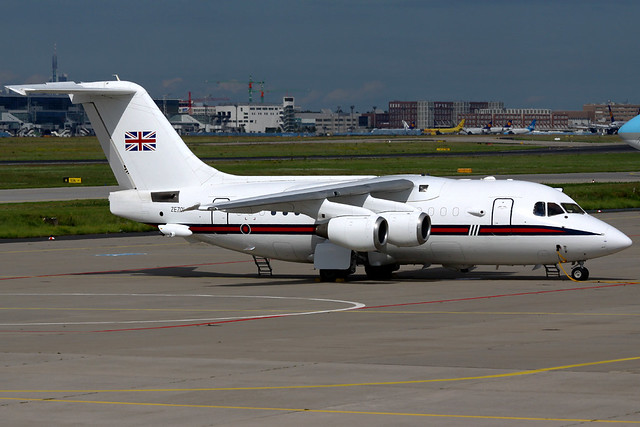
A BAe 146 Series 100 of the Queen's Flight.
Over the ensuing years, the 125 has become something of a legend. From its first flight in 1962 it remained in production for fifty years! Improvements were made along the way culminating in the 125-800 as shown below. A further increase in range capability with a fuselage extension gave rise to the 125-1000 of which 52 were made. Nearly 1700 aircraft were produced in total.
A BAe-800. This was really the definitive development. It was a huge success and no less than 600 were built. A long range version with a fuselage extension was produced and identified as the Series 1000.
Sadly along the way, for reasons best known to the decision makers in these matters, the 125 programme was sold to Raytheon in the US which in turn took over Beechcraft and ultimately the aircraft was known as Raytheon Beech, Hawker Beech and other iterations. Unhappily, Beechcraft got into financial difficulties and ceased trading in 2013.
-----------------------------------------------------------------------------------------------------------------------
Part Three: The Great Planes of Canada!
Our arrival in Canada came as something of a shock. Firstly the weather was unusually severe for early December -even for Canada. My arrival on the scene in the Sales office provoked a second negative reaction. It was a far cry from the "clubby" atmosphere at Hatfield where Sales personnel had offices usually shared between three or four salesmen. There were pictures on the walls -some even had carpets on the floor! All shared a view from the windows of the A1 (Great North Road) which whilst not exactly scenic, was a far cry from the de Havilland Sales Department. This consisted of closely-packed steel office cubicles with a vinyl floor and a view restricted to the neighboring cubicle and occupant. This austere accommodation would be my company habitat.
A further and more disturbing factor was to learn that my area of operation would be not North America as promised -but the Far East! I quickly made another discovery that our leader, the V.P. of Sales and Marketing who had interviewed me at Paris had a less than enviable reputation. He was subject to extreme mood swings, was a complete autocrat and was subject to making or changing decisions in accord with his current mind set. I soon discovered this for myself when I had the temerity to remind him of his statement made at Paris. He merely scowled and said "Well, I've changed my mind" -end of story! I had to accept it. There was no alternative. The one consolation was knowing that I would be away from home less than 50% of the time rather than more, which was a slight improvement. However the whole thing left a nasty taste in the mouth and provoked several "Welcome to the DHC Sales Department" comments from my colleagues which was a little disconcerting.
de Havilland (Canada) enjoyed a unique reputation world wide for its series of successful short Take-Off and Landing designs (thankfully contracted to "STOL".) In addition to the Dash 7 there were two other designs being offered, the 18-seat Twin Otter which had already sold in the hundreds and the larger Buffalo military tactical freighter, operated by several foreign air forces and significantly by the Canadian Government mainly in the Search and Rescue role. Interestingly their first ever design had been the DHC1 Chipmunk, the beautiful little training aircraft on which I had cut my aviation teeth at Booker 35 years previously. In a way, the wheel had turned full circle.
As the images show, the configuration of the Dash 7 was not unlike the 146 with high wing, T-tail and four engines. The use of four engines was problematical. Whilst they were a version of the widely operated Pratt and Whitney PT6 turboprop, inevitably the cost of overhauling four engines and propellers would be greater than two. The huge STOL flaps plus their operating mechanism was an extra cost and whilst the airfield performance was dazzling, the maximum cruise speed was 235 knots which diminished with the higher altitudes and largely cancelled out the fuel economies that were to be expected. It was also slower than the Dart Herald had been 20 years earlier!
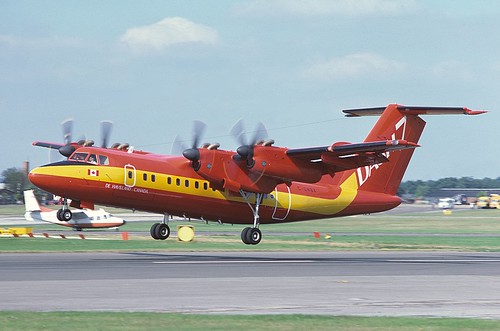 The first Dash 7 prototype became the company demonstrator -in which I accumulated many hours.
The first Dash 7 prototype became the company demonstrator -in which I accumulated many hours.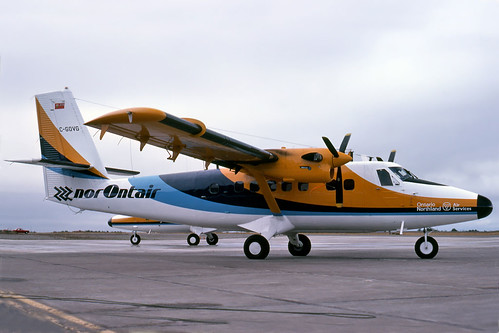
Series 300 Twin Otter. Norontair was an excellent Government-assisted airline providing invaluable links between many remote Northern Ontario communities.
The rugged and impressive Buffalo, capable of operating from small unprepared strips.
Despite the Vice-presidential decree, my first trip representing de Havilland was to Rocky Mountain Airways based in Denver, Colorado, the launch Dash 7 customer. The President, Gordon Autry was the nephew of famed Holly wood cowpoke, Gene Autry. The Dash 7 delivery had only been a couple of weeks earlier when I was tasked with escorting a group of Australian airline people visit the airline and sample the aircraft in service. This would include a flight to the popular ski resort of Aspen, one of the key Rocky Mountain destinations. Our return flight to Denver was unforgettable as due to a 1 hour weather hold overhead Stapleton on its previous flight the toilet had overflowed. A pungent composite aroma of urine, vomit and chemicals was pervasive throughout. Whilst the grey water had a separate receptacle, the basic toilet had just its integral bucket which had been woefully inadequate! Subsequently, modifications involving the provision of a separate holding tank were installed as a top priority!Shortly after my "immersion" training in toilet facilities I made my first trip the the Far-East in the company of the person whom I would be replacing. In the circumstances what could have been a stressful inauguration turned out to be the opposite. In fact I believe that he, being over 60, had had enough of the travel anyway and as he would be merely transferred to the Contracts Department, he would not really lose anything. At we progressed on our trip it was clear that he had lost whatever sales personality he might have had at one time. His presentations were to be frank dull and boring. Paradoxically, his personality perked up when not "on stage" and he made a good travelling companion. At the trip's end my passport had become much more "lived in" with stamps from Thailand, Burma, Malaysia, Singapore, Japan and Okinawa.
A Burma Airways Fokker F28 looking in far better condition than when I flew in it.
The next two years were the most difficult of my career. In each country it is normal to appoint a local company well versed in local affairs, to promote the products and act as a "Consultant" -which is just a more respectable word for "Agent". Any success in making sales was handsomely rewarded in commission entitlements. This potential windfall tended to attract some unsavory companies and avaricious individuals.In almost all countries comprising my territory, I discovered that there were problems, usually involving questionable ethics or shady dealing. For example in Korea, and unknown to de Havilland, the appointed agent (an international Korean trading company) also represented CASA, a Spanish company producing a competitive aircraft! By acting exclusively for de Havilland he was able to block and suppress any interest in de Havilland products -unbelievable! I subsequently discovered that the company President was a friend of his counterpart in CASA.
A further example, this time Japan, presented a different problem. For some inexplicable reason the consultancy company was British. In the xenophobic attitude existing in Japan at that time, the appointment was inexplicable and stupid. A third was in Burma where the consultant also represented Fokker, a direct competitor. Little could be done in this case due to the oppressive regime headed up by the tyrannical Ne Win. Moreover, any commissions would be channeled for "onward dissemination"into the appropriate hands. Nevertheless the fact that our man drove me around in a Fokker-donated car gave me pause for concern. In Thailand the small company representing de Havilland was comprised of a father/son combination. They were continually put under duress by a variety of "mob-like" entities clamoring for a piece of the pie! In fact, a clandestine character in the hotel lobby, having ascertained that I was "Mr Bird" warned me to be careful! The consultants were very alarmed and confirmed that this was a definite threat, warning me to stay clear -or else.
In Korea, after a highly stressful confrontation with the Chairman, the company was fired and replaced. In Japan the British company was fired and replaced by one of the six biggest trading companies in Japan. This I thought was the end of the story. However, the President of the division representing de Havilland, whom I had interviewed, got to know well and liked, had got himself involved with another aircraft company where it was alleged some illegal pay-off money transfers had been made. The whole saga became front page news in Japan. On my next visit I had arranged an appointment to meet with him. However, it was not to be since on the day prior to our meeting, the President, under considerable stress, committed suicide. Some time later in Thailand, the father of the duo, mysteriously died. Subsequently the son arrived on the doorstep in Downsview which was a shock in itself, but then, clearly scared for his life, he implored me to assist him get a job at de Havilland I could do no more that to pass on his request. Nothing was available, he left and I often worried what became of him.
There were times when the aircraft I was tasked with selling seemed secondary to the dramas that were unfolding. I did manage to arrange two demonstration tours by an itinerant touring Twin Otter and a Dash 7. However, even these were agonizing affairs. The arrival of the Twin Otter in Bangkok occurred two hours after a scheduled Korean section was cancelled without reason -due to the activities of the CASA enthusiast described above. The last straw was to discover that the Twin Otter pilot seemed to be suffering from a serious emotional disorder. He had his wife with him (-totally against company rules) presumably for moral support. Having discovered that Korea had been cancelled he completely lost his cool and subjected me to profane, high volume verbal abuse, all in the lounge of one of Bangkok's premiere hotels. The following morning he was completely contrite, apologizing for his dreadful behaviour and begging for forgiveness. His demonstration flying performance was expertly conducted but in the process he put the aircraft into maneuvers outside its operational envelope. At the time I wondered what would befall of him.
* His sorry story is summarized in the insert at the end of this section.
Some months later the Dash 7 arrived (-resplendent in a dramatic new colour scheme) in Bangkok Its arrival coincided with the sudden cancellation of the entire programme by Thai authorities. The de Havilland Director of International Sales who was leading the Dash 7's tour took me to task for screwing it up. I contacted the Canadian Embassy but although very helpful and understanding, it was unable to change anything and felt that sinister forces were behind it. Happily they were able to assure the above Director that there was absolutely nothing I could have done. Our visit to Kuala Lumpur accomplished little as there were no perceivable prospects. However in Singapore ultimately a Dash 7 sale to Mobil oil was made although the demonstration had little to contribute.
This never-ending series of negative events was beginning to affect my health. Fortunately there was one bright spark. The Burmese section of the tour was a great success although with Fokker in the driver's seat chances of sales success were low. However, we were well looked after considering the run down, cash poor and shabby state of the country. In addition to Rangoon we paid visits to some some exotic destinations including Mandalay and particularly Pagan where hundreds of religious pagodas dot the countryside. It was a truly magical place -almost spiritual and the kind Burmese people added to the experience.
 Mandalay -where we were treated like pop-stars! Hundreds of spectators were pressed against the fence.
Mandalay -where we were treated like pop-stars! Hundreds of spectators were pressed against the fence.
Pagan; some of the hundreds of pagodas that dot the landscape.
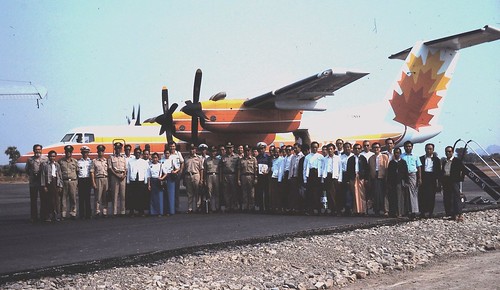
We had a full aircraft for our upcountry visit. Here at Pagan, a commemorative shot before leaving. The new Dash 7 livery was favorably commented upon. The new tarmac was courtesy of the Canadian Government.
* * *
* Insert.As mentioned above, the future activities of the errant pilot who had publicly humiliated me in the Bangkok hotel make interesting history. With his propensity to "push the envelope" it wasn't long before it caught up with him. In the 1984 Farnborough Air Show, flying a Buffalo in front of many thousands of spectators, flying too slowly, he misread the wind speed and direction, lost control of his rate of descent and crashed on the runway. Although he and his copilot survived, the aircraft was a complete wreck. However, a picture or a YouTube video is better than words.
https://www.youtube.com/watch?v=UgX4YOUqVtE
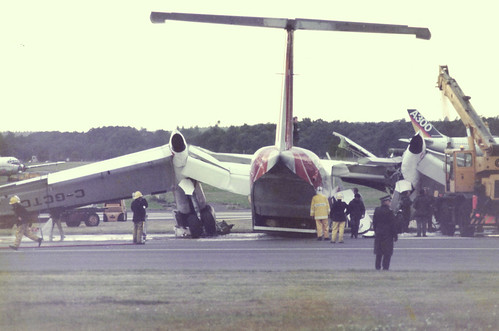
Farnborough 1984. Without doubt the Buffalo demonstration was the most dramatic!
As a result of the crash, he was removed from flying duties and offered another job within the company which his ego precluded him from accepting and he left the company. Three years later whilst delivering a Piper Cherokee aircraft to a customer, he crashed in a snow covered forest in Newfoundland. After having 16 hour "chillin'" time to reflect on his predicament, he was finally rescued suffering with a broken foot.
In November 1998 he was carrying out a test flight on a Dash 7 in Devon in the UK. Apparently he was in the process of checking out a stall warning and stick shaker setting. For some inexplicable reason the aircraft configuration (including the wrong flap setting and with one engine inoperative) was set up incorrectly and the autopilot left engaged. The result was that the aircraft entered a spin and crashed into a field killing both occupants. The following is a section of the official accident report which is fairly damning:
"Although both pilots were familiar with the test schedule the aircraft was not correctly configured
for this particular test. Furthermore, the autopilot was retained down to the point of the stall and
there appears to have been no adequate response to the stick shaker. If the crew were unaware of
the flap configuration error then the stall warning may have surprised them but for a crew of their
experience to fail to react correctly to the compelling intervention of the stick shaker is most unusual.
The available evidence therefore suggests that normal crew operation and co-ordination was lacking during this phase of flight. In the absence of a working CVR it is not possible to state why this occurred."
1998
The Dash 7 crash in Devon UK. -all that remained.
* * *
Now to return to my chronological narrative. Although I didn't realise at the time, I had only one more visit to the area before our leader at Downsview suddenly made a course change, something for which he was renowned. The entire international sales force was reallocated. I, (along with a couple of other ex-patriot Brits) was reallocated to the North American market which is where I had assumed I would be working from day one. This was a huge improvement to our domestic situation as at worst I would be home every -or at least most weekends, plus additional periods when I was not actually on the road.Compared with what had just transpired, this was like a long term vacation. Over the next few years I travelled throughout much of my adopted continent. The process of making sales couldn't have been easier. Indeed many of the contracts that fell into my sales clutches were merely additions to existing fleets. In the USA, the Airline Deregulation Act of 1978 opened up a thirst for new aircraft and with it new opportunities for de Havilland. Even the Dash 7 which despite its disadvantages of speed and 4 engined configuration became sought after. In still-regulated Canada the situation was very different. Smaller airlines found it difficult to expand or upgrade their fleets and were constantly opposed by their larger strong-armed brethren. As a result, considerable numbers of old, obsolete re-engined aircraft remained in service. It was obvious that a deregulated industry would be a prime candidate for new aircraft
The Convair 580 was a turboprop conversion of an older piston-engined design.
The venerable DC3 (or C47). Amazingly, Buffalo Airways of Yellowknife N.W.T. still operates them in 2014!
The Saunders ST27 was a twin turboprop conversion from the 1950's 4 engined de Havilland (UK) Heron. Air Atonobee of Peterborough, Ontario, operated a fleet of these.
By the mid-1980's following the example of the deregulated American airline industry and after a lengthy period of bureaucratic huffing and puffing, the government released a position paper "Freedom to Move". This led to the long awaited deregulation of the airline industry. Wishing to capitalize on this, in anticipation I had been focussing my efforts more and more on the Canadian market. I was given the title of Director, Canadian Sales and thus armed I made a concerted effort to enhance the company's viability and commitment, something which had been sadly neglected, and of which I was forcibly reminded on several of my early visits.
de Havilland had a new dynamic President, John Sandford who was a far cry from the somewhat staid, conservative management of the past. He could see that the company had been presented with an enormous opportunity. A completely new clean sheet of paper design was crystallized, this time not by the design department, but as a result of a findings of a market analysis group who visited airlines around the globe seeking feedback from their own wish list.
Finally, after a commendably short period of design fine-tuning the Dash 8 emerged. Whilst being a high wing t-tailed design as was the Dash 7, here the commonality ceased. Rather than stressing short take-off/landing characteristics, the Dash 8 concentrated on maximizing efficiency, including much higher cruise speeds.Two versions were projected; the 36 seat Series 100 and the 50 seat Series 300. By any standards the new Dash 8 possessed the sleekest lines of any DHC design.
The aircraft on which I had been involved over my preceding years in the industry had all possessed certain shortcomings. The same could not be said of the Dash 8 which was the epitome of what it was aimed to be. One of my Canadian customers, the provincially sponsored norOntair, was to be the launch operator. norOntair was comprised of nine Twin Otters operated by three Ontario airlines under the administration of the Government as part of Ontario Northlands which also included rail and ferry services in its portfolio. The government involvement could have been potentially stifling, but norOntair was a very fine organisation in fact among the best to be found anywhere. I was honored to be invited to be a passenger on the world's first Dash 8 revenue flight in December 1984.
The aircraft on which I had been involved over my preceding years in the industry had all possessed certain shortcomings. The same could not be said of the Dash 8 which was the epitome of what it was aimed to be. One of my Canadian customers, the provincially sponsored norOntair, was to be the launch operator. norOntair was comprised of nine Twin Otters operated by three Ontario airlines under the administration of the Government as part of Ontario Northlands which also included rail and ferry services in its portfolio. The government involvement could have been potentially stifling, but norOntair was a very fine organisation in fact among the best to be found anywhere. I was honored to be invited to be a passenger on the world's first Dash 8 revenue flight in December 1984.
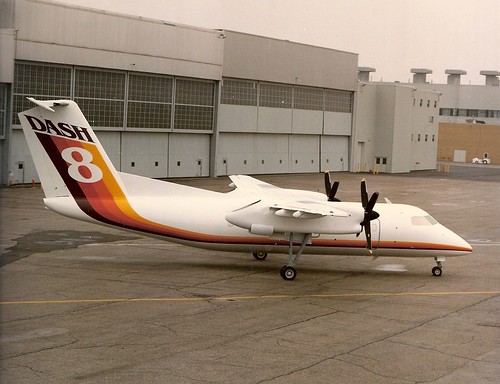
The sleek first prototype Dash 8 leaves the paint shop and awaits its registration letters.
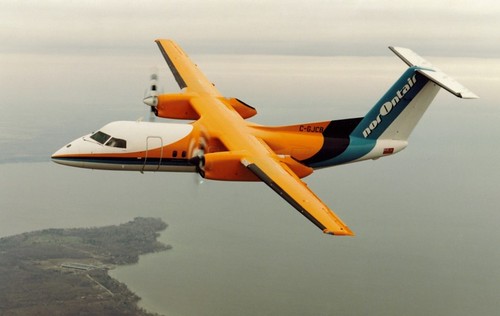
The first Dash 8 to be delivered.
At this time, a particular project that took up far more of my activities that it should, was the idea of operating a Dash 7 service out of Toronto Island Airport. Commonly referred to my the printed media as "The STOL" it encouraged a group of five disparate airlines, some embryonic, to provide an up-market air service, particularly aimed at businessmen, from the Island Airport to Ottawa and Montreal. Commonly referred to among themselves as "The Golden Triangle" its main attribute was that it completely eliminated the tiresome journey to and from the main Toronto (Lester Pearson) Airport and replaced it with a short 5 -10 minute taxi ride from the business heart of the city to the island facility. Indeed the door to door time by Dash 7 to either downtown Ottawa or Montreal was less than that of a DC9 from Lester Pearson. Special efforts were made to provide excellent on board breakfasts and a good bar service for the evening trip home. The fares whilst not excessive were reasonable and to compensate there was no expensive cab ride from Lester Pearson to considerOn the face of it it appeared a great idea. However, it was stalled for several years by the activities of City Hall which included an infuriating left-wing faction dedicated to stopping it. As company representative (or watch guard) I spent many frustrating and exhausting sessions attending debates on the subject, some extending to midnight. The subject under discussion often appeared secondary to the obsessions of councilors with scoring points over their political opponents. My presence there was fully justified on several occasions when completely untrue and misleading statements were made by the "nays".
When it was finally approved, the outcome was quite bizarre. Air Atonabee, which already held a licence to operate small ST27's as shown in the image above, was in the process of being bought out by a long time airline executive Victor Pappalardo, who immediately applied for authority to operate Dash 7's. He managed to access two used Dash 7's immediately and by so doing effectively put paid to the long term efforts that had been made by the other aspirants. It was a classic end-run. He then decided to move into Dash 8's as well and far too much of my time and efforts -even weekends, were spent virtually acting as an unpaid consultant. His demands were never ceasing. Moreover, with "The STOL" now a going concern I was obliged to have little dealing on the subject with the other disappointed contestants.
Since this was a high profile project on our doorstep, it was necessary to promote it as much as possible. Accordingly there were demonstration flights round the area and a high profile Press Day at the Island Airport. Fortunately throughout all the hassle, I could always count on the full support of our President, John Sandford, without doubt the best boss I ever had.
Eventually Victor got his stuff together and with the name "City Express" the airline got going. Sadly the service provided was a far cry from the business-orientated service which had been envisaged. The name "City Express" was aimed at a similar market to the American cut-priced Peoples' Express. The quality was minimal, on-board service was virtually non-existent and his staff seemed glad to get work -any work. It was devastating to see something which after years of delay with such promise to degenerate into a bargain basement "people-mover" attracted by low fares.
City Express, which became known as "Shitty Distress" limped on until 1991 when thankfully it closed its doors. It had done us no favours. In fact its overall impact on de Havilland was probably negative. However several years later as will be related in the conclusion, a new operator appeared and its name became synonymous with efficiency and excellent service. It went on to expand far beyond anything previously envisaged in the "The Golden Triangle" era.
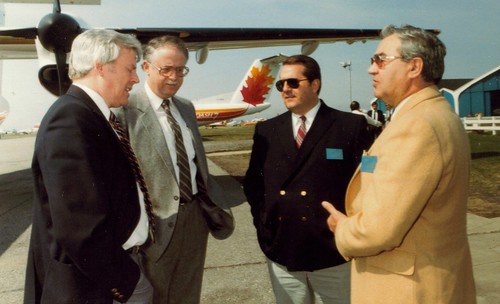
City Express Press Day. Having brought a Dash 7 and a new Dash 8 to the Island airport,
we await the arrival of the media. From left to right, John Sandford, President of de Havilland; Victor Pappalardo, President of City Express, and Joe Czumrik ex President and founder of the original Air Atonabee.
we await the arrival of the media. From left to right, John Sandford, President of de Havilland; Victor Pappalardo, President of City Express, and Joe Czumrik ex President and founder of the original Air Atonabee.
A City Express Dash 7 on the ramp at Lester Pearson Airport. It must have been freshly delivered as I can never remember seeing any of their fleet looking so clean!
* * *
With the arrival on the scene of the Dash 8, demand for new Dash 7's evaporated. Since the first prototype Dash 7 was a perfectly sound, fully furnished aircraft, management was generous in agreeing that I could use this well- traveled aircraft for promotional purposes across Canada. This resulted in regular appearances at local airshows as well as several regional promotional tours. particularly in the more remote areas up the east coast of Hudson Bay and the northern parts of Newfoundland and Labrador. It was after the latter that we were very fortunate to avoid what could have been a major disaster!* * *
On our return from Newfoundland, we visited Halifax where we took a party of about 25 local dignitaries and politicians for what had been intended as a routine tour of southern Nova Scotia. However, on this occasion we decided to carry out a low level flight over the remote boomerang-shaped Sable Island some 300 km south East of Halifax, famous for its sand and wild horses.
The pilot and I had agreed that should the surface condition be satisfactory, we would consider carrying out a landing. However, instead of carrying out a slow, low flypast to assess surface conditions, he decided to land anyway. All was fine until just before the aircraft stopped. Suddenly with a sickening lurch, one of the main wheels broke through the icy crust. None of the full-power full-flap attempts to move were successful. We were stranded!
Fortunately for us, members of the Meteorological Station, the only buildings on the island, appeared with shovels and dug us out. To reduce weight, all the passengers were asked to disembark onto the snowy, icy, windblown, freezing sand, no doubt cursing the day that de Havilland arrived in town! Having got the aircraft moving again I hoped that we were in the clear. It was not to be. This time all three sets of wheels broke through. It was a nightmare. Was this to be the final resting place of the first Dash 7 to be built. A group of us, following the directions of the met. scientists went on foot to identify a more solid surface area which had been occasionally used by far lighter Britten-Norman Islander and Twin Otter aircraft to bring essential supplies. I am perfectly sure that my feet had ever been so cold!
This time all three landing gear units required digging out. Then with full power and flap it managed to reach this firmer area, and the passengers invited to re-embark. By this time they were extremely fearful. Indeed in some cases it bordered on panic! Eventually with maximum take-off power applied, the pilot released the brakes. Had there been another breakthrough during the next 20 seconds, it would probably have resulted in a deadly cartwheel over the offending wheel with a consequent break up. Happily,the prayers of the terrified passengers were answered, and it was with enormous relief when, through a side window I saw the starboard wheels leave the ground.
The cabin was very quiet on the return flight to Halifax. I'm sure several dined out on their genuinely harrowing experience for some time thereafter!
The cabin was very quiet on the return flight to Halifax. I'm sure several dined out on their genuinely harrowing experience for some time thereafter!
Sable Island showing the Meteorological Station buildings.
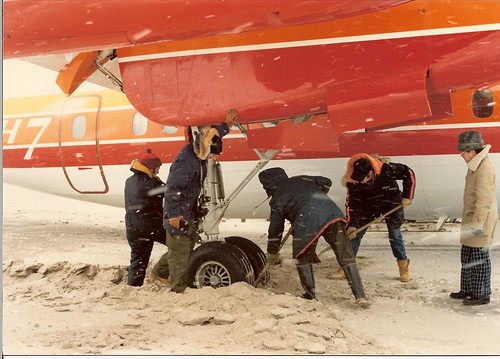
Without the invaluable assistance of the Meteorological Station staff, we would probably still be there!
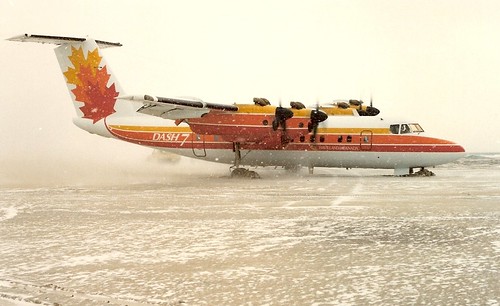 This was the point when I wondered if this would be the final resting place of Dash 7 number 1 - a monument to impetuous stupidity!
This was the point when I wondered if this would be the final resting place of Dash 7 number 1 - a monument to impetuous stupidity!* * *
Despite making numerous presentations around the area, and in spite of many positive remarks, there were no local takers. It took Air Dale, one of the norOntair airlines based in Sault St Marie Ontario(!) to pick up the challenge. Bob Dale, the owner and myself spent a great deal of time and effort on bringing it to fruition. I was even given leave to accompany Bob and his wife Kellie on a tour of the Maritimes, visiting each community to be served. We flew in Bob's veteran Beech 18 and were well received. It was a memorable and totally enjoyable trip.
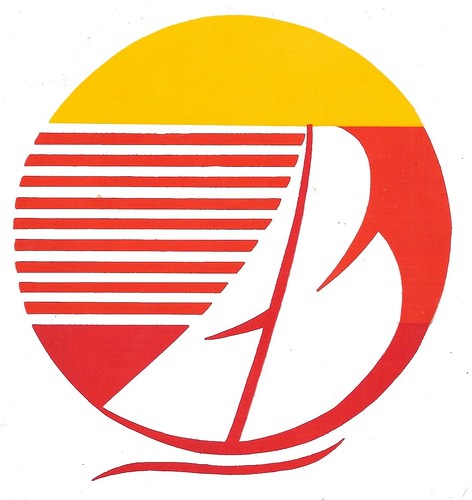
My Air Bras d'Or logo
I deliberately chose the 'sunny'
colours instead of blue/green
which is a bit predictable in the Maritimes

One of the two Air Bras d'Or Twin Otters at Sydney, Cape Breton
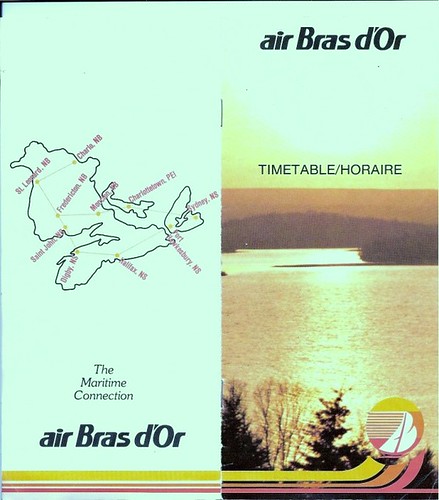
The timetable, now thankfully with the "O" in d'Or capitalized.
Bob had always assumed that I would run the airline myself from Sydney. I did pay a visit there with the family to assess the situation -including visiting local schools for the children. However, we were not overly impressed and I was not prepared to take the very considerable risk in leaving my current position. Unfortunately Bob employed a totally inept local husband and wife management combination who in the space of three months virtually ran the thing into the ground. On one of my regular sales visits to the area I took an Air Bras d'Or flight incognito from Halifax to Fredricton. It was very disappointing for a variety of reasons. Bob eventually replaced the pair with a senior highly respected norOntair executive. However, much damage had been done and he replaced the whole concept of local point-to-point service with one that mainly fed the major airlines in Halifax and other large centres. This was at the expense of local point to point service (e.g. Charlottetown - Moncton - Fredricton direct. It had been always had been necessary to go through Halifax!) It continued to operate for about two years, then with little prospect of expansion, it was decided to wrap up the entire enterprise and sell the aircraft. At the end of the day, thanks to the governmental input, monetary losses were insignificant.
Without doubt, had it been competently marketed and advertised it could have prevailed. However, I was really the one to blame as being its creator, I was the sole individual who understood its mission objective, the entire local air service concept but was not prepared to take the plunge, grasp the nettle -or any similar metaphor!. Still it was great fun while it lasted!
The most noticeable feature of this electric powered model was its shape, which was that of a somewhat thin doughnut complete with a hole in the middle. It was 15 feet in diameter. Its design principle differed from that of a conventional airship in that it was heavier than air. The doughnut shape was the lift envelope containing helium whilst a fan mounted in the central duct of the envelope provided lift in the vertical axis. Under the envelope was a circular payload compartment, around which were mounted four smaller fans, 90 degrees apart to generate thrust in any direction in the horizontal axis either collectively or differentially.There were also four much smaller fans on the periphery of the envelope to provide stability.The function of the latter was purely automatic, being connected to a small attitude gyroscope, requiring no input from the pilot. Remote control was provided by a fairly straightforward radio-control system similar to that used in model aircraft. I was invited to "fly" it and with its "relaxed" responses to control inputs found it to be extremely easy to control -and great fun! It was all fairly simple and effective and with the combination of its doughnut shape being unaffected by wind direction and being heavier than air (-and not requiring to carry ballast) would overcome much of the control and handling of conventional cigar shaped airships in docking and departure. I became very interested and spent much of my spare time in attempting to predict some of the development problems it might encounter as well as a projected marketing plan.
During this time a man-carrying version was being built by Ultraflight in Port Colborne, which had enjoyed considerable success in building the popular Lazair ultralight aircraft. I visited the factory one weekend and was impressed at the progress. Unfortunately, the only real obstacle to the project was the President of the Hystar group who in addition to being completely non-technical was totally unable to express himself without hyperbole. He offered me the position of V.P. Marketing without much fleshing out as to what it involved. He would have made the consummate used-car salesman. Nevertheless things were progressing apace and the model was to make daily demonstrations at the upcoming EXPO 86 in Vancouver. I was invited to attend and took some vacation time, staying in the President's very nice apartment overlooking False Creek.Its appearance every thirty minutes was nothing short of sensational. I can only assume that the President's metier was that of a being a fixer and I assume he must take credit for the exhibit. Housed in its own small section of pavilion with ample space for spectators, the Hystar was kept behind a large clam-shell structure which at "show time", opened and to the strains of the 2001 film score the Hystar rose in a cloud of dry ice and then briefly demonstrated its abilities over the heads of the spectators. There were many armed with cameras, particularly the Japanese visitors who were falling over each other to get the best shot.
On the down side, the Hystar was part of a coincidental Lighter Than Air Conference at nearby Boundary Bay Airport at which many presentations were made by visitors from around the world. The President gave a talk and despite being urged to keep the tone low gave a totally inappropriate address full of exaggerated BS. Indeed when he announced that the Hystar would effectively render all helicopters redundant there was ill-concealed laughter from the audience. He also provoked some cringing by repeatedly referring to it as Canada's Flying Saucer! I believe that this debacle was a major factor in the demise of this totally worthwhile project.
Sadly from the successful flight demonstration at EXPO 86, it was all downhill. All contributors to the project seemed to get at odds with the President, in particular Ultraflight, which was constructing the first man-carrying version. Things began to get nasty and it was time to get out which is what I did -despite assurances that things would be just fine.
A patent application was filed in 1986 which I assume has been the reason that no one else has taken it on. There was still activity as recently as 2011 where hyperbole is still the order of the day!
See:
https://www.youtube.com/watch?v=FFVKyo_VmSY
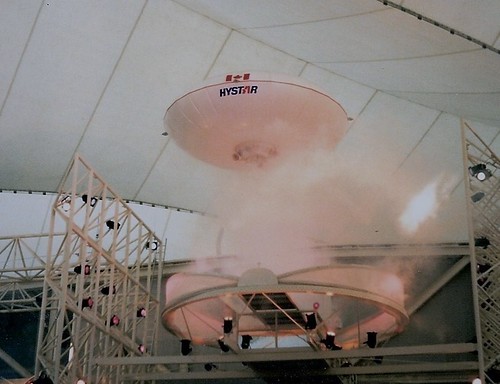
EXPO86: To the strains of the "2001" movie, the Hystar leaves its clam-shell lair!

EXPO86: A good shot of the underside showing the central duct and all of the fans.
Looking back at all this there is no doubt that these were my halcyon years. In addition to all the excitement just described, my Regional Sales Manager, Gordon Preece and I repeatedly criss-crossed the country visiting anyone who would give us their time. This and promotional exposure provided by the Dash 7's frequent promotional appearances, PLUS a first rate product to sell ultimately resulted in results beyond my wildest dreams. Several airlines who grouped themselves together under the collective cryptic, "ABCD Airlines" had sensibly recognized that there were powerful financial benefits which would result from one large order rather than several smaller ones. They submitted a proposal to buy 42 Dash 8's with a further 10 options. At the time this was the biggest order ever received for de Havilland, Canada. It did't end there. Having primed the pump, the orders continued to come in from across the country. By the end of 1986, Dash 8 sales in Canada were close to 100. Sadly during this time Gordon left the company to join Dornier in a more senior position. Happily we and his family remain friends to this day. Had company policy included commission payments, Gordon and I would have been quite wealthy men!
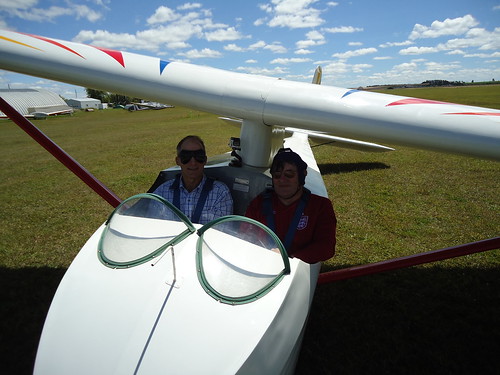
What goes around, comes around. Shortly after finishing this magnum opus at the end of October 2014, I received this recent picture from Gordon Preece. Wearing the cool shades, he is sitting (left) in a beautiful T21 glider, the type in which I did my basic training in UK, nearly 50 years earlier! (-see picture in Part one).
I now found myself in an odd predicament. I had effectively sold myself out in Canada! What would I do now? de Havilland Canada was now owned by Boeing, Seattle. Would I now be surplus to requirements? The answer was not long in coming. Following on from the success of the Dash 8, a slightly smaller version of 23-30 seats was planned -with a difference. This time an innovative arrangement was entered into with Short Bros of Belfast. This involved two designs; ours at Downsview, which was in effect a scaled down Dash 8 and for Short Bros, who was given carte-blanche to push the envelope - did just that. With a guiding hand from Downsview, they came up with a unique design featuring a low wing with its two engines buried in the rear fuselage driving two counter-rotating propellers. With the two engine intakes on either side of the fuselage it looked much like a miniature BAC 111. The two designs would be known as the NRA 90A and B respectively (NRA was an acronym for New Regional Aircraft).
With no outstanding Dash 8 business, I was asked to devote some time to these joint projects. There were two immediate tasks to carry out. In the company of a market research expert, I would visit selected airlines across North America with a standard format presentation plus a fairly detailed questionnaire on the comparative merits of the two designs which they were invited to answer. After this we would then visit Europe and carry out a similar exercise. Finally, I would attend the Paris Airshow with a small exhibit including models of both the A and B versions. All this went extremely well. The airlines chosen appreciated being consulted and were very helpful. However, I was increasingly concerned at the operating costs of both, particularly the unorthodox version. The design sophistication and build complexity of the designs would be similar to the Dash 8, but in this case there would be a maximum of under 30 fare paying bums to generate revenue.
At the Paris Show, my small stand required active (even physical!) persuasion to get the attention of passers-by. However, once those who stopped became aware of its message, many others showed up eliciting numerous comments and suggestions. As word got around, an increasing number paid a visit and by the conclusion of the show there was no doubt that this this product introduction had achieved its purpose.

My small exhibition stand at the Paris Air Show. The NRA 90A (mini Dash 8) is visible behind the revolutionary NRA 90B.
Sadly the effort was all in vain. Before the end of the year the project was suddenly cancelled without warning. As this came on top of the previous decision by Boeing to wind up the Buffalo and Twin Otter production, and with the Dash 7 winding itself up, only the Dash 8 remained.
This time however, there were no worrying concerns relating to my immediate future. I was offered the grandiose position of -as my business card proudly proclaimed "Director of International Sales". The title was mainly to impress status-conscious airline executives who liked to think that that were dealing with "the top man". In fact there were five of us to cover the globe. Nevertheless, it meant higher corporate status, a secretary, three salesman, a non-travelling sales administrator, a Sales Engineer when required, a salary adjustment and -my own office and parking area! My territory would be China and the Pacific Region. Because of language, cultural and societal concerns, one of my salesmen C.C Kuo -"CC" to everybody, was a speaker not only of Mandarin but also Cantonese and Taiwanese. Without his active participation the job would have been very difficult.
Other than China much of my area included countries already familiar to me from the past. However this time was very different. Now, with 8 additional years of paying my dues, I felt far more knowledgeable, and self-assured -bordering on the arrogant . "Just bring the buggers on, I know all about their crap". To attempt any sequential account of my activities of the following five years would amount to little more than a travelogue. Suffice it to say that it involved 52 crossings of the Pacific (26 in each direction!) Sufficient to maintain a life lived in continuous jet-lag!
Without question the most educational region was China. All my visits took place before the economic explosion of the past 15 years or so. As had been the case years previously in Africa, I was able to experience something of the history and lifestyle before it disappeared under the avalanche of technology that has effectively expunged much of what constituted their ancient traditions.
As far as commercial aircraft of Chinese origin there were really none, save the Twin Otter-sized Harbin Y12, sales of which, due to "relaxed"Chinese airworthiness requirements, were exclusively to third world countries. More significantly they entered into a manufacturing arrangement with DHC to manufacture Dash 8 nose cones and smaller components. However, Xian Aviation did produce the Russian AN 24 under licence in some numbers, known as the Y7. Elsewhere the familiar mix of Boeing and Airbus equipment was much in evidence, but there was also a fleet of 35 Tridents, the sale of which had required the Hawker Siddeley Sales Director, Johnny Johnstone to take up residence in China.
All commercial aviation was controlled by the Civil Aviation Administration of China (CAAC).
Harbin Y12
A Chinese Trident looking more like it should!
The Tridents seemed to be held in relatively good esteem but as is the often case with Chinese airliners, many looked a bit shabby. One morning on one of my frequent visits to Hong Kong, I turned on my TV and was confronted by the alarming picture below. On landing in heavy rain, a Trident had hit the end of the runway promontary causing a main landing gear unit to be torn off. It veered to the right, left the runway and ended up in Kowloon Bay. There were seven fatalities including six crew members. A similar accident had happened a few years earlier in Yangshuo where a Trident again in rain hit a mountain and killed all 112 occupants.
Not the best way to start the day! This Trident hit the runway lip, tore off a landing gear and veered into Kowloon Bay resulting in 7 fatalities.
Over the years the safety record in China has not been the greatest. So much so that "CC", my Regional Manager, refused to fly on any (CAAC) flight unless completely unavoidable -hardly a ringing endorsement! One occasion I was approaching Shanghai in a CAAC MD 82, for some inexplicable reason, the captain rashly announced that we had started our descent, whereupon there was a rush of passengers to the front of the cabin to be first out. Orderly line-ups are are unknown in China. The effect on the aircraft centre of gravity on such an aircraft configuration can be imagined by referring to the picture below! It was only after physical restraint from the cabin staff and the panic in the voice of the captain that they reluctantly returned to their seats. It was 15 minutes or more before we landed. In general cabin security on internal flights was mediocre. To see cabin staff asleep in spare seats during flights was not uncommon.
An MD 82. The long nose makes movement in the cabin very sensitive to aircraft trim.
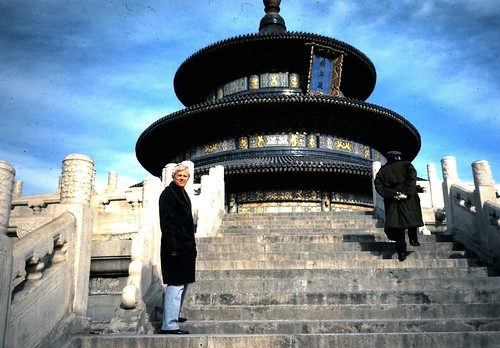
Not a Chinese flying saucer but the Temple of Heaven in Beijing!
A contract with Zhejiang Airlines for three Dash was signed just before my arrival on the scene. The airline was ultimately absorbed by Air China. Hangzhou, where the Airline is based, overlooks the magical West Lake, and was my favorite Chinese destination. The old town in particular is beautiful and has a magical feel to it. On the other hand the business centre is well laid out, very attractive and stands comparison with any town inside or outside of China.

The beautiful bridge over West Lake, Hangzhou; the origin of the Willow Pattern design.
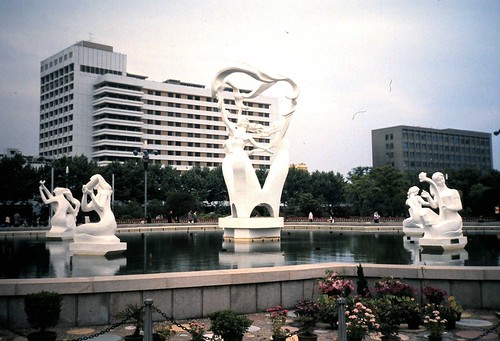
Hangzhou; the attractive city centre.
* * *
We had considerable success in Taiwan, selling 10 Dash 8's to Great China Airlines which sometime later was taken over by the giant EVA company and finally absorbed by its subsidiary, UNI AIR. * * *
However, Taiwan was my least favorite country. Taipei, its capital is modern but ugly. The inhabitants are less laid back than their neighbors on the mainland. They seem to suffer an ongoing neurosis that they may be overrun by the communists at any moment. The main feature of the city is the truly huge memorial to Chang Kai Shek which covers several acres.
We were successful in selling 10 Dash 8's to Great China Airlines. This company was taken over by the giant EVA organisation and subsequently absorbed into UNI AIR
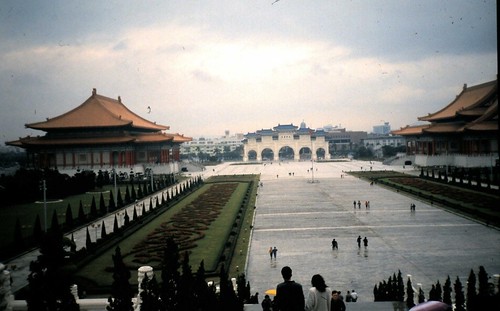
The massive Chang Kai Shek Memorial with a Concert Hall on one side and the National Theatre on the other.
* * *
If Taiwan was my least favorite port of call, surprisingly perhaps, Japan was my favourite. Notwithstanding its size and population, everything worked and most importantly I found that virtually everyone with whom I came in contact was polite, courteous and no matter what, was anxious to prevent me "losing face". The de Havilland "consultant" was still Nissho Iwai, the organisation appointed on my previous go round when the president of the department concerned with our affairs committed suicide -the day before I had a meeting scheduled with him! My main contact was Fumio "Tony" Takano, a splendid fellow who exemplified all of the characteristics mentioned above and was to become a very good friend as well as colleague.
The only commercial airliner manufactured in Japan was the NAMC YS-11. This was a 64 seat turboprop which had been in service since the mid nineteen sixties. Its most noticeable feature was its similarity to the Hawker Siddeley 748. To me, it appeared as if its overall design had evolved from taking the design configuration of the 48 seat 748. By setting their slide rules at 1.4 and redoing the numbers they would have come up with a design very similar to the YS-11! Even the Rolls Royce Dart engines of the 748 had been suitably up-rated to provide the necessary power. Nevertheless it was successful. Some even made their way to the USA, Piedmont Airlines in particular. Just over 180 examples were built.


A beautiful shot of a YS-11 climbing away.
Initially there were two main prospects to focus on; Air Nippon Kinkyori (ANK), a subsidiary of ANA and South West Air Lines (SWAL), a subsidiary of Japan Airlines (JAL), both of which operated YS-11's. Also. the third airline Japan Air System (JAS) also had long term potential and later on was taken over by the all powerful Japan Air Lines. However the Okinawan-based SWAL also operated a fleet of Twin Otters many of which operated from short runways. Therefore all my visits to Japan involved a side trip to Naha, Okinawa. In all I visited the Ryukyu Islands 30 times!
In order to make the maximum impact of these visits and to physically demonstrate an interest in their activities, I made a 3-day tour of the islands, flying SWAL aircraft on their route network. For this I was accompanied by Sales Engineer Steve Young who was a valued companion on many of my Japan visits. We had arranged a couple of meetings with SWAL managers at some of their larger destinations but for other smaller sectors through which we transited, we planned to travel incognito and accordingly "dressed down" as vacationers. This latter proved to be a complete failure as we were identified as soon as we checked in for our first flight on Day 1. Subsequently we increased our level of sartorial elegance with long pants and open-neck shirts! By the conclusion we were treated as celebrities!and endlessly quizzed for our assessments of many aspects of their airline's operation. Not surprisingly, SWAL was no different from the main islands of Japan -everything worked and worked well!
The entire exercise was well worth doing, genuinely appreciated and certainly forged a closer relationship.
In order to make the maximum impact of these visits and to physically demonstrate an interest in their activities, I made a 3-day tour of the islands, flying SWAL aircraft on their route network. For this I was accompanied by Sales Engineer Steve Young who was a valued companion on many of my Japan visits. We had arranged a couple of meetings with SWAL managers at some of their larger destinations but for other smaller sectors through which we transited, we planned to travel incognito and accordingly "dressed down" as vacationers. This latter proved to be a complete failure as we were identified as soon as we checked in for our first flight on Day 1. Subsequently we increased our level of sartorial elegance with long pants and open-neck shirts! By the conclusion we were treated as celebrities!and endlessly quizzed for our assessments of many aspects of their airline's operation. Not surprisingly, SWAL was no different from the main islands of Japan -everything worked and worked well!
The entire exercise was well worth doing, genuinely appreciated and certainly forged a closer relationship.

So much for keeping a low profile. Day 1 Flight 1. We discovered that the SWAL bush telegraph was very active and we received a warm welcome from this SWAL lady prior to boarding one of their Twin Otters.
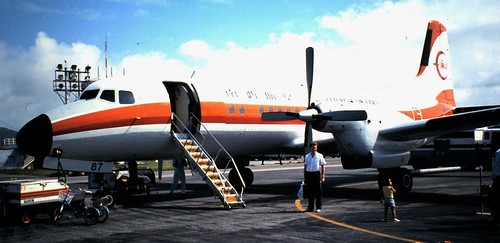
Steve modelling our semi-formal attire before boarding a SWAL YS-11. Even the flight crew knew we were coming and Steve travelled in the cockpit!
As a point of interest, this shot of the smaller 748 was taken at a similar angle to the YS-11 above, where the similarity between the two designs can be seen.
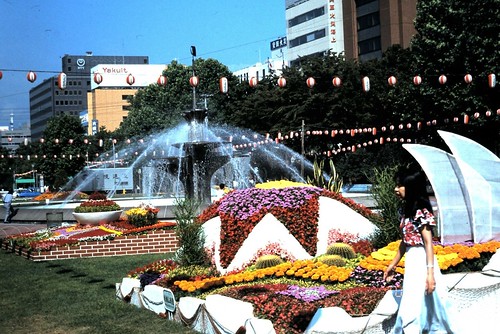
This trip was unusually productive. From Naha we flew to Tokyo where early the following morning we met Tony Takano and took a flight to Sapporo, on the northernmost island of Hokkaido where we presented a route study to ANK. We had travelled from one end of the Japanese Archipelago to the other in under 24 hours! Sapporo is a very attractive city featuring a very wide main street Odori. Indeed so wide is it, that it is regarded as a park. In the centre was an outstanding floral display stretching along its length which also includes fountains and statues. Below are two of the many creative displays. Apparently there had been some Canadian influence in the early 1900's particular in agriculture, which is reflected in the Toronto like grid street layout, street car, and grain silos.
Before returning to Tokyo we had time to visit the 90m ski jump built for the 1972 Winter Olympic Games, the first to be held outside Europe or the USA.
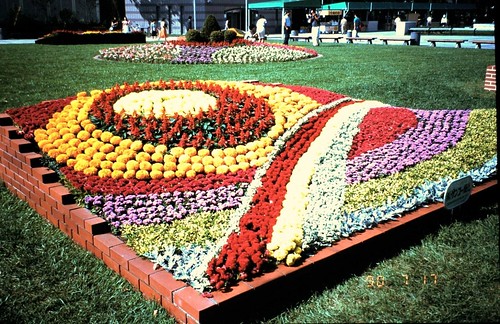
Before returning to Tokyo we had time to visit the 90m ski jump built for the 1972 Winter Olympic Games, the first to be held outside Europe or the USA.

Sapporo; one the remarkable flower displays that line the main street.

So beautiful is Odori that it warrants a second picture -including a Japanese girl with a matching blouse!
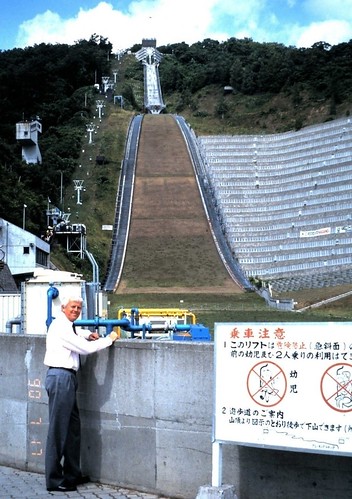

Before returning to Tokyo, we made a brief visit to the 90m ski jump
used in the 1972 Winter Olympic Games.
Another JAL airline, JAir was an offshoot of Japan Air Academy, based in Omura, Nagasaki. At the time of my visits, they had an office in another city whose name will live forever; Hiroshima. It was clear from current traffic levels that a 36 seat aircraft was too big at present but plans for future expansion were being considered. I felt it important to keep in touch particularly considering the close connection with JAL. British Aerospace had been successful in selling five Jetstream J31's to the airline to replace unpressurized Embraer Bandeirante's. From all I could gather, BAe's efforts had been minimal.The requirements had been 19 seats, pressurization and 3-abreast seating. The Jetstream had been the only design that filled all three requirements. Accordingly Tony Takano and I arranged a meeting with J-Air at Omura which would coincide with the inaugural Jetstream flight to Hiroshima which proposed to take the following morning. We were amazed that no one from BAe was on hand for the event. It was interesting to fly in a Jetstream again, my first in over 20 years and first ever in a furnished version. It was quite impressive. After our meetings I related some of my (sanitized!) Jetstream war stories. Our hosts seemed as interesting in this as our as the Dash 8 information.
We had time to visit Peace Park, the epicenter of the atom bomb attack in August 1945. The "Atomic Bomb Dome" perhaps the most famous building in the world remains as it has done ever since the explosion. It was a profound experience to walk round the tranquil and beautifully laid out Peace Park and then to visit the museum with its many harrowing exhibits, was a profoundly moving experience that I will never forget.
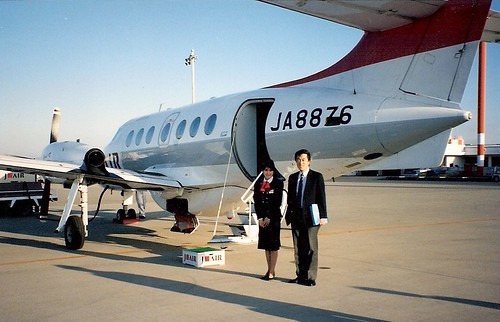
Tony Takano and a J-Air lady prior to the first Jetstream J31 flight from Nagasaki to Hiroshima.
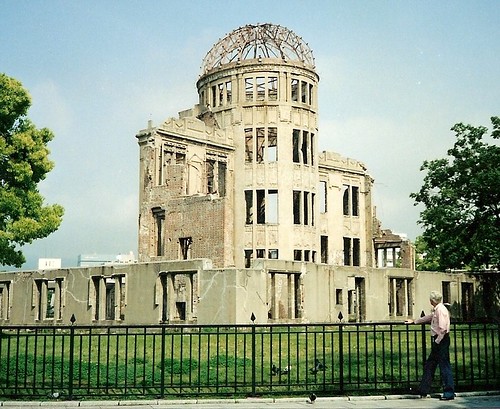
The Atomic Bomb Dome In Hiroshima
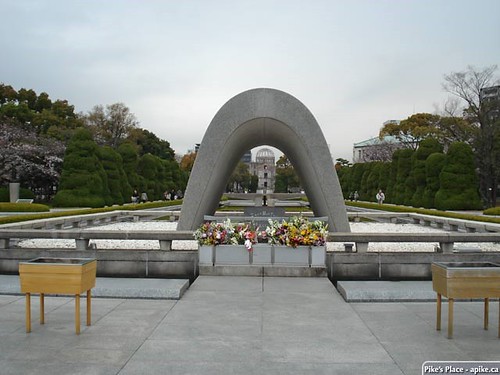
Hiroshima: -looking along the Peace Park through the Cenotaph to the Atomic Dome behind. The Cenotaph contains the names of 247000 of the known victims.
Some time later I was asked to give a talk on local/regional air service to the Japanese Aerospace Association. This was quite an honour. Thanks again with Steve's assistance we put together a study on an imaginary Japanese airline. Throughout, the city pairs served and the assumptions used were entirely and typically Japanese. I was surprised at how well it was received. At its conclusion I was invited into an inner sanctum at the back of the hall and presented with a Nikon Camera for my efforts. This was a bit awkward as company policy expressly forbade accepting gifts. Had I refused, all our hard work of the preceding years would have been for naught as the rejection would have resulted in a massive loss of face to JAA
Our presentation to the Japan Aeronautical
Association (J.A.A) went very well. We had a good turnout of 100 Japanese aviation luminaries. A full report appeared in the next edition of Aerospace Japan.
* * *
Although I visited South Korea on numerous occasions, at the time in question. the country was not yet ready for domestic airline operations. Nevertheless I paid my dues to Korean Airlines and the brand new Asiana Airlines, both chiefly international carriers. My activities could be best described as "missionary work"!
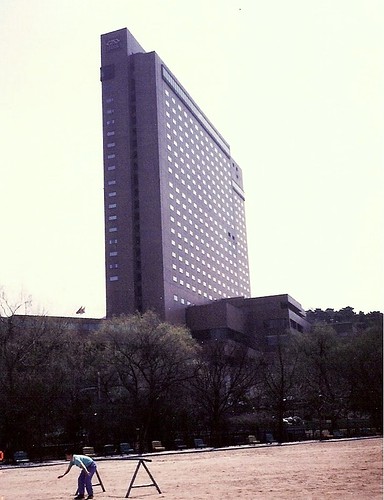
Paradoxically, the nearest I came to selling Dash 8's to Korea -as will be mentioned later, was five months after I left the company! If nothing else, it gave me a two-week all expenses paid stay at my all-time favorite Shilla hotel.
The Gold Medal for my
favourite hotel goes to Seoul’s “The Shilla” on Jangchung-Dong Rd..
* * *
The Philippines presented different obstacles. There was certainly a requirement for Dash 8 type aircraft, but for the foreseeable future this need was being met by some Fokker F50's. This type was a revamped and stretched development of the venerable and highly successful F27. It was a direct competitor to the Dash 8-300, but it beat the de Havilland product to the marketplace by at least two Years. It was sold to PAL largely on the reputation of its admirable F27 predecessor which PAL had previously operated and which had sold a total of 586 units. The F50 programme continued until the later 1990's, totaling 213 sales before running out of steam.
Notwithstanding their current fleet composition, I always found a surprisingly welcoming audience among the PAL hierarchy for updates on the Series 300 -and particularly the 70 seat Dash 8-400 which I continued to promote, despite the fact that no production go-ahead had been given.
Significantly, I note that in 2008 they introduced a fleet of 5 Dash 8-400's -PLUS 4 Dash 8-300's. If there ever was an example of continuing to press on even when conditions seem pointless, this was it; even if it took many years after my departure to bear fruit.
There were several occasions when I was approached by "wannabe" start up airlines. Fortunately in most cases it was possible to defuse their enthusiasm by treating them as bone fide aviation specialists. By using airline jargon and standard aviation terminology it was fairly easy to expose their ignorance by asking questions the replies to which revealed the extent (or lack) of their knowledge. In one case however the aspiring ego-driven airline tycoon had managed to secure the services of individuals whose credentials were genuine. It had the unlikely name of "Air Pacific Crake" This case went so far as to being given a letter of intent for several Dash 8's together with a somewhat sketchy request for a route/cost study. Being unable to refuse, the company had no recourse but to comply, tying up a substantial amount of Sales Engineering effort. Eventually thanks in part to inside information obtained from one of his specialists -who was well aware of our predicament, the real situation and all the B.S surrounding it enabled me to put a halt to any further time wasting. When I brought forward his source and terms of financing, necessary for a definitive cost study, he suddenly disappeared. Unfortunately these wild goose chases which are by no means unusual, do nothing for the reputation of the salesman with his superiors.
There was another organisation with the supremely unlikely name of "10 Knot Tours" was showing interest in a purchase. As just related this is a real dilemma. If an incorrect assumption is made questioning or prejudging the credibility of a customer, the outcome is never a happy one. In this case the company concerned had Japanese principals and the strange name was a typical example of picturesque Japanese use of English. Ten Knots referred to their core business which had been in ocean cruises carried out at speeds of around ten knots.
This organisation was developing ecological tourism in and around the Philippine island of Palawan situated in the south-west of the Philippine archipelago. Air service was provided from Manila to an unpaved landing strip on the small island of El Nido using an elderly Series 200 Twin Otter and an Islander. I was asked to carry out an assessment of the runway suitability and to show good faith was offered a huge discount to make a visit and stay over the weekend.
It was a revelation. Following a somewhat tedious two hour transit to El Nido, it was necessary to take an outrigger for a 45 minute trip to the island of Miniloc. It is a real tropical paradise, beautifully run and by restricting guest numbers to a maximum of 54, overcrowding is never an issue. It was so impressive that sometime later -thanks to a healthy number of frequent flyer points, during one of my visits I was able to make a side trip with my wife for a memorable week at the resort.
Sadly the economics of getting into the airliner business with a new 36 seat aircraft was out of the question, the most effective alternative would be to enter into an agreement with an existing company to buy the hours required to provide the air service.
Eventually to improve on the tedious 2 hour air transit time, 20 seat Dornier 228's were employed for some time. Although unpressurized the speedy 228 knocked 30 minutes of the flight time.
 Margaret my wife, awaits the boarding call to her awaiting B-N Islander which at the time was dedicated to the El Nido run. Its destination "El Nido", is just visible on the rear fuselage
Margaret my wife, awaits the boarding call to her awaiting B-N Islander which at the time was dedicated to the El Nido run. Its destination "El Nido", is just visible on the rear fuselage
The Islander and elderly Twin Otter were replaced by speedy Dornier 228's
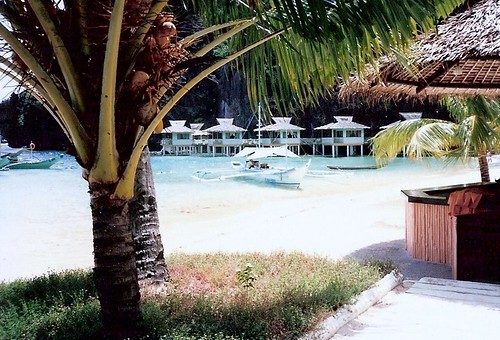
El Nido; we stayed in one of these water cottages.
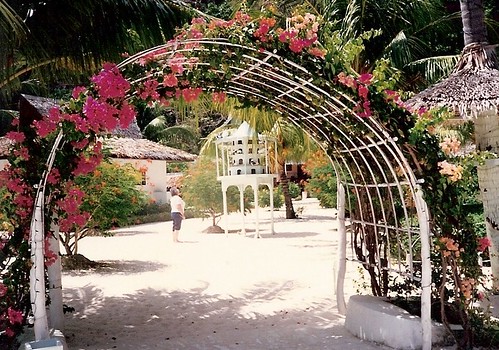
Margaret inspects the bird house located in the centre of the resort.
I visited Hong Kong over 30 times. In addition to paying my dues at the prestigious Cathay Pacific Airlines and Dragonair, Hong Kong was a useful hub for visiting China, Philippines, Macau and Taiwan. I had appointed a consultant on my earlier visitations to the region. Tommy Cheung was and is, a quite extraordinary character. In Addition to being the Chairman of the large Pacific Group insurance company, he is one of the most genuinely altruistic people I have come across anywhere. In addition to providing much in the way of scholarships and other education assistance to young people, particularly women, he is also honorary Vice Consul for Sri Lanka, effectively providing a proxy embassy for visitors from that country. He was even responsible for building a school at Shatin on the mainland which bears his name. Such is his benevolence he was even presented to the Pope as a picture on his office wall bears witness. He was always on hand during my visits and I have lost count of the number of dinners hosted by him for me. Transportation was available at any time; not just any old car but at least a BMW or Mercedes. Tommy also owned a Roll Royce and a new Daimler which on occasions were also brought into the mix. However to arrive for a airline meeting in a luxury Daimler was a problem as it did not give the right impression! 
Margaret inspects the bird house located in the centre of the resort.
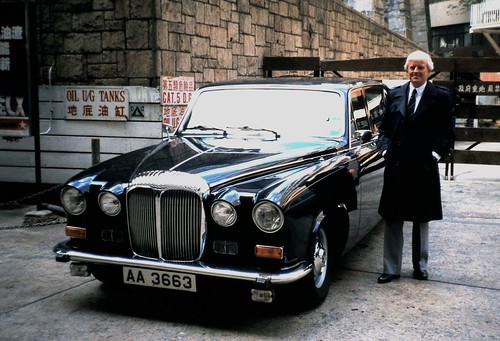
Tommy's Daimler limousine, the same model as that used by the Royal Family!
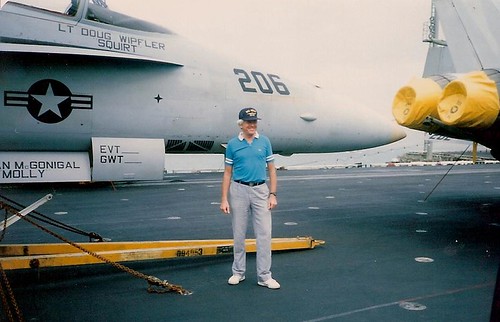
On USS Midway. The flight deck was state of the art. but below decks it showed much evidence of its 40 plus years.
After our holiday in El Nido, Margaret returned to Canada from Hong Kong via Cathay Pacific Airways whilst I got back to work and headed north into China. However, not before on our final night, we were picked up by Tommy's launch from a dock near our hotel and after a cruise around Hong Kong Island, docked at the village of Aberdeen. Here, Tommy and some of his executives hosted dinner in the famous "Jumbo" floating restaurant. An unforgettable gastronomic experience! 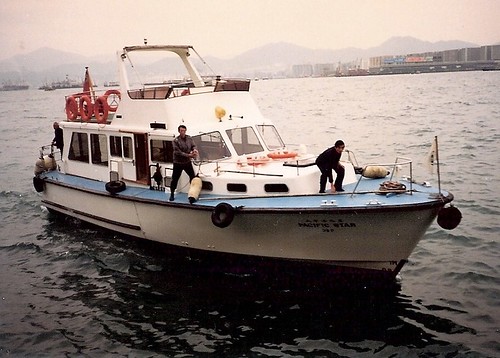
Tommy's boat "Pacific Star", arrives to pick us up for a cruise to the village of Aberdeen
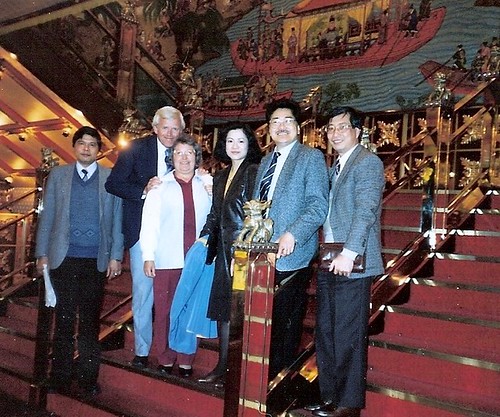
At the "Jumbo" floating restaurant at Aberdeen. -Tommy is second from right.
* * *
After five years of continuous jet-lag I was getting tired. After a undistinguished ownership of de Havilland, and having lost a major Canadian sale to Airbus, somewhat churlishly Boeing decided to sell the company. Together with Canadair, Lear and Short Brothers, de Havilland eventually became part of the exploding Bombardier company. I and several other 50+ year old Sales Department people were given early retirement. One of my closest contacts, Alan Hubble (another Director of Sales) and I decided to do some consultancy work on our own.
Tyrolean Airways, the excellent Austrian airline, decided to upgrade their Dash 8-100 fleet with 50 seat Dash 8 -300's. Alan, who knew Tyrolean from previous sales activity was asked for assistance. There was a start-up airline in Korea interested in buying the Dash 8-100's. Its president, Roe S.Y. was the nephew of the Korean President, Roh Tae-woo and, surprise, surprise had some very influential contacts. I visited Korea with Alan and after some meetings with Roe, Alan left me there and returned to Canada.
Consequentially, I found myself back at the Shilla hotel in Seoul. After many hours spent with "SY" and his team plus frequent to and fro contacts with Alan back Toronto and Tyrolean at Innsbruk, the deal was on the verge of signing when disaster struck in a major way. The Korean President was suddenly arrested and charged with treason, mutiny and corruption. He was subsequently convicted and initially sentenced to death -something which was later commuted! Nevertheless he was jailed.
Immediately our promising project with nephew Roe S.Y. vanished -as did he. No one wanted to have any dealings with him. I packed my bags and returned to Canada. We never heard anything of SY again.
A Tyrolean Airways Dash 8-100.
In conclusion, I should make mention of the Dash 8-400; updates on which I had been making for the previous five years. It had always generated interest but with no hardware that's as far as it went. Eventually the decision to go ahead was made. With a new engine, the Pratt and Whitney PW150A rated at over 5000shp and an amazing 4850shp maximum continuous rating, the 400 has a maximum cruise speed of 360knots (414mph), much faster than its predecessors or competitors. This has penetrated the smaller end of the jet market and many are operated by large airlines such as Air Canada usually under the umbrella of commuter subsidiaries.
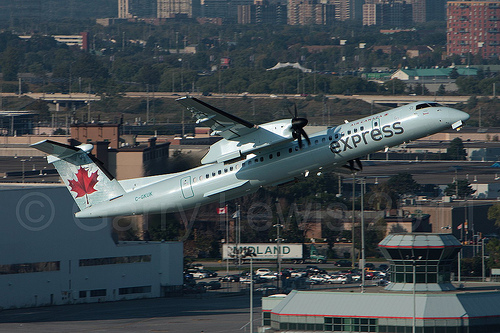
A fine shot of an Air Canada Express -400 climbing out of Toronto Island Airport
A Ryukyu Air Commuter (RAC) at Naha Airport Okinawa. RAC was previously known as South West Air Lines (SWAL) referred to above and a "default" destination on my trips to Japan.
Rereading through all the foregoing it seems that I must have had more stamina than I was aware of! I now concentrate on more earthly pursuits such as cycling, paddling, walking and when my antique skeletal components permit, running. My four grandchildren already participate in these activities and hopefully continue to appreciate how fortunate we all are and to live where we do.
